Archive for the ‘Threats from Deforestation’ Category
Sunday, September 4th, 2011
Whilst touring Tasmania’s highland country in 2009, we stopped over in the old rural town of Bothwell.
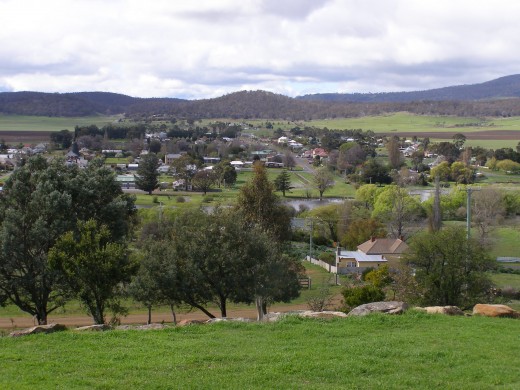 A pastoral Bothwell ~ an ode to the British countryside A pastoral Bothwell ~ an ode to the British countryside
looking from Barrack Hill over the River Clyde
(Photo by Editor 2009, free in Public Domain)
(click photo to enlarge, then again to enlarge again)
.
Bothwell is historically known for its colonial exploration dating back to 1806, its convict past dating back to the 1820’s, and for its soldiers’ barracks, and for its pastoral colonial heritage.
Its namesake was derived from a town in Lanarkshire, Scotland; likewise the naming of the River Clyde.
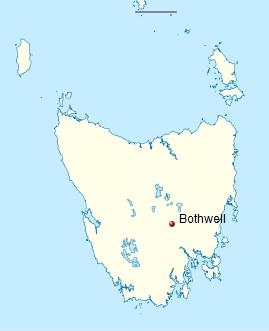 Bothwell
Situated in the Tasmanian South East Bioregion Bothwell
Situated in the Tasmanian South East Bioregion
.
Few will know of the prior Tasmanian Aboriginal heritage of the 5 bands of the traditional Tasmanian tribe (kinship group) the ‘Teen Toomle Mennenyer‘ of this highland and river region. Many were either massacred, rounded up and put into missions, or succumbed to European diseases. Most were dispersed from their traditional lands by 1832. This otherwise labelled ‘Big River Tribe‘ likely due to the big river country characterising this fertile inland region; rivers of which subsequently named the Derwent, Ouse, Clyde, Shannon, Weld, Styx, Plenty, Jordan, Lake, Isis and Pine, amongst others.
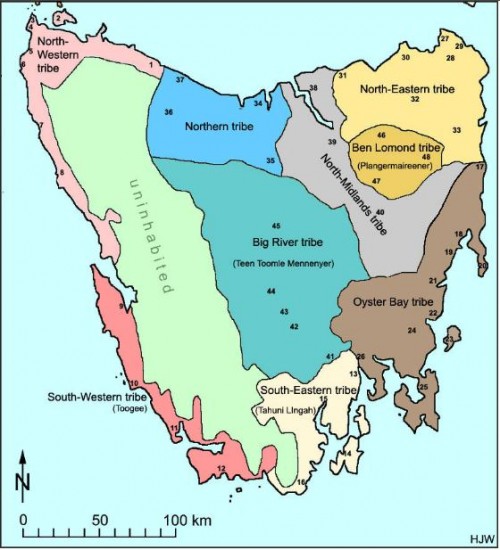 Traditional Aboriginal Territories of Tasmania Traditional Aboriginal Territories of Tasmania
.
Even fewer will know of the extensive tall Tasmanian Swamp Gum forest that for thousands for years blanketed this lush river valley, prior to it being clear-felled for timber and to make way for colonial pasture.
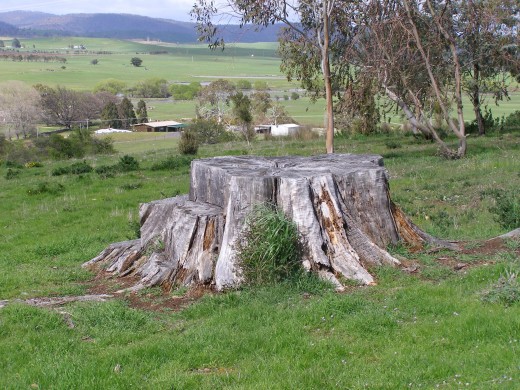 ‘Dead Heritage’
Stump of a Tasmanian Swamp Gum (Eucalyptus regnans)
on Barrack Hill, overlooking Bothwell
(Photo by Editor 2009, free in Public Domain
(click photo to enlarge, then again to enlarge again) ‘Dead Heritage’
Stump of a Tasmanian Swamp Gum (Eucalyptus regnans)
on Barrack Hill, overlooking Bothwell
(Photo by Editor 2009, free in Public Domain
(click photo to enlarge, then again to enlarge again)
.
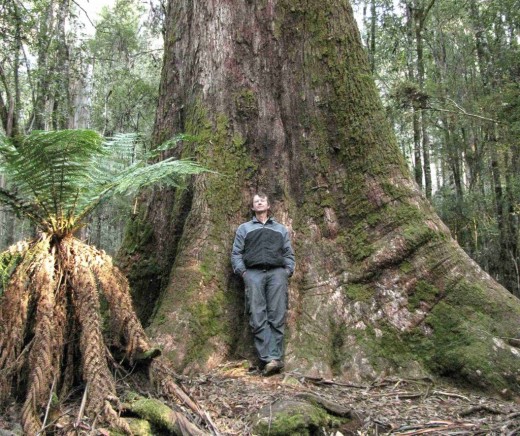 ‘Tasmanian Natural Heritage’
‘Tasmanian Natural Heritage’
Tasmanian Swamp Gum
The type of Swamp Gum forest around Bothwell
that would have greeted the colonists back in the 1820s
(© Photo Magi Nams)
Source: http://www.nams.ca/MagiBlog/tag/tasmanian-snow-gum/page/2/
.
.
Fifty kilometres down the road from Bothwell on the tourist drive, lies the old colonial town of Oatlands. The old Callington Flour Mill in the town has become a tourist attraction and has recently been restored aided by a $1.2 million grant by Australia’s Minister for Trade, Simon Crean, in 2007.
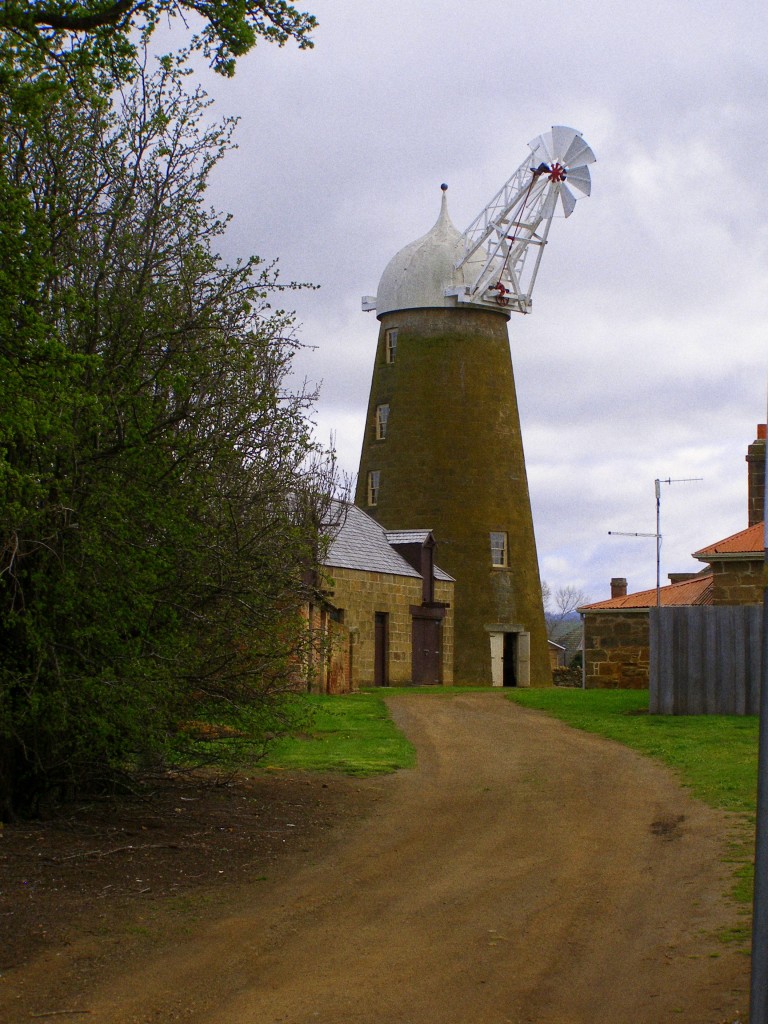 ‘Tasmanian Colonial Heritage’
Oatlands’ Wind Mill
The 1837 landmark Callington Flour Mill, recently restored
(Photo by editor, September 2009, free in Public Domain)
‘Tasmanian Colonial Heritage’
Oatlands’ Wind Mill
The 1837 landmark Callington Flour Mill, recently restored
(Photo by editor, September 2009, free in Public Domain)
.
Part of that restoration involved adding new structural posts in its interior. The following photo is of a rather new looking hardwood post inside the mill. It looks like local Messmate/Stringybark (Eucalyptus obliqua), generically marketed as ‘Tasmanian Oak‘.
.
Other local timbers sold as ‘Tasmanian Oak’ are Alpine Ash (Eucalyptus delegatensis) and Swamp Gum (Eucalyptus regnans).
On Mainland Australia, Eucalytus regnans is referred to as Mountain Ash ~ once the world’s tallest tree species, once taller than the Californian Redwood.
 The environmental cost of Tasmanian Tourism
A new ten inch (wide) post inside Oatlands’ restored mill,
probably from local Messmate/Stringybark (Eucalyptus obliqua)
(Photo by editor, September 2009, free in Public Domain)
. The environmental cost of Tasmanian Tourism
A new ten inch (wide) post inside Oatlands’ restored mill,
probably from local Messmate/Stringybark (Eucalyptus obliqua)
(Photo by editor, September 2009, free in Public Domain)
.
.
.
.
.
Further Reading:
.
[1] ‘The Traditional Tasmanians‘, ^http://www.andaman.org/BOOK/chapter52/5-Tasmania-traditional/traditional.htm [Read More]
.
– end of article –
.
Tags: Big River Tribe, Bothwell, Dead Heritage, Eucalyptus globulus, forgotten forest, Oatlands' Callington flour mill, stump heritage, Tasmania, Tasmanian Aborigines, Tasmanian Blue Gum, Tasmanian Natural Heritage, Tasmanian South East Bioregion
Posted in Tasmania (AU), Threats from Deforestation, Threats from Tourism and Recreation, Threats to Wild Tasmania | No Comments »
Add this post to Del.icio.us - Digg
Saturday, September 3rd, 2011
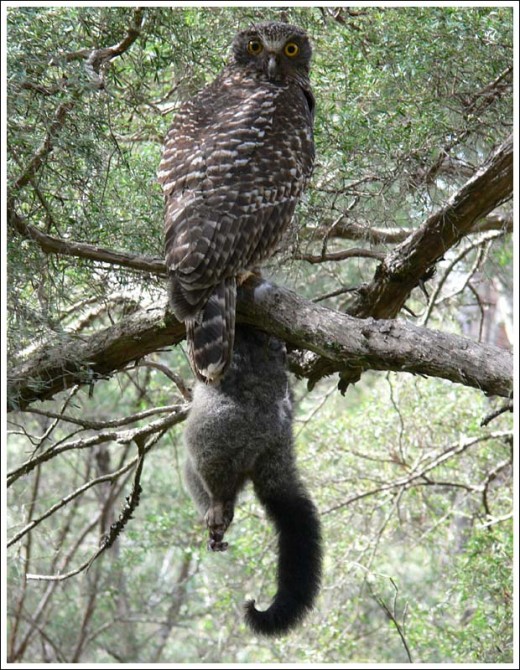 Australia’s native Powerful Owl with native prey – a juvenile Brushtail Possum (2kg?) Australia’s native Powerful Owl with native prey – a juvenile Brushtail Possum (2kg?)
© Photo by Duncan Fraser
^http://www.natureofgippsland.org/
.
Powerful Owl Call
(turn on your computer volume)

.
.
Drought, bushfires…it’ll take years to find out what’s happened to Victoria’s Forest Owls
.
[Source: ‘Something is knocking the states owls off their perches‘, by John Elder, The Age newspaper (Victoria, Australia), 20100613, ^http://www.theage.com.au/victoria/something-is-knocking-the-states-owls-off-their-perches-20100612-y4s0.html]
.
‘What’s happened to Victoria’s carnivorous owls? A significant number have vanished, and the (Victorian) Department of Sustainability and Environment (DSE) isn’t sure what’s going on.
It’s assumed the top end of the woodland food chain is either starving to death because its food source has been killed off by the drought and fires, or it is relocating to parts unknown, but it will take years to find an answer.
The DSE has been monitoring the owl populations – including that of the Powerful Owl, Australia’s largest owl – since 2000. Since then, detection rates in South Gippsland and the Bunyip State Park have dropped by half.
In some areas of the Bunyip State Park – half of which was lost to the Black Saturday fires – detections of the Sooty Owl have dropped to a third.
DSE owl specialist Ed McNabb says: ”We don’t know what’s happened to them. We can only assume that drought has played a major role. We noticed the downward trend before the fires. They’re very mobile birds, but the fires would have had an impact on their prey.”
Powerful and sooty owls, both officially listed as vulnerable, mainly eat sugar gliders and ringtail possums. The possums in particular are known to have little resistance to chronic hot weather, and their failure to thrive in the drought is the main reason why owl numbers have dropped.
While owls may have escaped (Victoria’s) Black Saturday fires, many possums would have been incinerated.
.
McNabb says the smaller carnivorous birds, such as the barking owl, are able to sustain themselves on insects. Powerful and sooty owls can also eat rabbits and birds such as magpies and kookaburras, but they need to make the change in their diet before energy loss reduces their ability to effectively hunt.
”They’ll either starve or take something else,” said McNabb.
Equally disastrous for the owls was the loss of old trees with large hollows that they require for nesting. They might have shifted elsewhere to recolonise, but this would mean taking over an already occupied territory. ”And there tends to be a home-ground advantage in these battles,” said Mr McNabb. The occupying bird has inside knowledge of the territory and a greater capacity to defend its patch, because it’s energy store will be higher. Flying great distances in search of food saps the strength from large birds and even causes them to starve.
The DSE’s biodiversity team leader for West Gippsland, Dr Rolf Willig, said:
The top order carnivores were ”an indicator species as to the well-being of the ecosystem.
Theoretically, if they’re happy, the rest are happy.”
.
For five years Dr Willig has been running a playback monitoring program in South Gippsland, where recordings of owl calls are played into the dark and answering calls are recorded. The number of birds answering calls have dropped significantly this year.
”The results indicate we may be having a delayed reaction from the fires,” he said. ”The possums not actually killed in the fires might have been exposed afterward, and the owls picked them off, eating all the food that was left.”
It will take years to find out what’s happened. ”And not just three or five years. We’ll be out here for a long time,” said Dr Willig.’
.
.
‘Conservation through Knowledge’ – a motto of leadership

The Royal Australasian Ornithologists Union is Australia’s largest non-government, non-profit, bird conservation organisation. It has sensibly branded itself as ‘Birds Australia‘, which in just two words says all that it is about, and the Emu family graphic is uniquely representative of Australia ~ the Emu being Australia’s largest bird.
Similarly sensible is its motto ‘Conservation through knowledge‘ which provides inspiration for conservation leadership, beyond Ornithology. The organisation was founded way back in 1901 to promote the study and conservation of the native bird species of Australia and adjacent regions, making it Australia’s oldest national birding association.
The Powerful Owl call above is sourced courtesy of Birds Australia.
.
.
Powerful Owl (Ninox strenua)
http://www.birdsaustralia.com.au/our-projects/powerful-owl-wbc.html
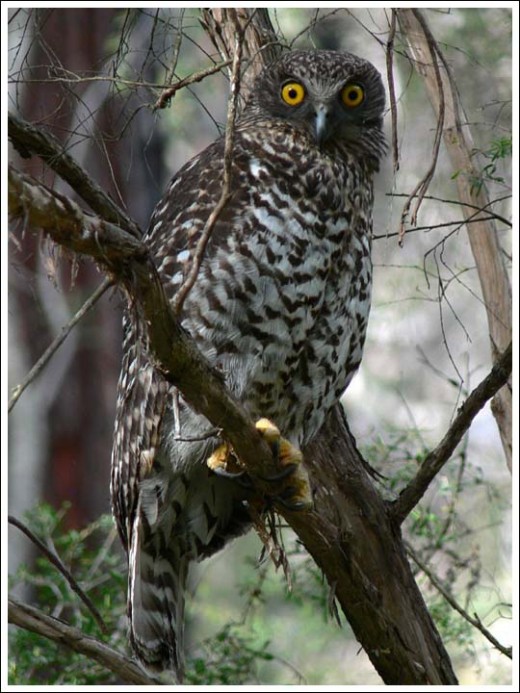 Powerful Owl (weighs under 1.5 kg) Powerful Owl (weighs under 1.5 kg)
© Photo by Duncan Fraser
^http://www.natureofgippsland.org/
.
A noctural top-order predator of tall old forests, the Powerful Owl is territorial, sedentary and monogamous ~ it calls one place home and mates for life (a lifestyle model for many humans).
.
HABITAT
Throughout most of its range this species typically inhabits open and tall wet sclerophyll forest, mainly in sheltered, densely vegetated gullies containing old-growth forest (where they breed in hollows in large trees) with a dense understorey, often near permanent streams. Such habitats are often dominated by Mountain Grey Gum, Mountain Ash, Manna Gum or Narrow-leafed Peppermint. They occasionally also occur in rainforest in gullies surrounded by sclerophyll forest or woodland. Powerful Owls also occur in adjacent open dry sclerophyll forests and woodlands, such as those dominated by box–ironbark eucalypts, Candlebark, Messmate or riparian River Red Gums; they sometimes also occur in open casuarina and cypress-pine forests.
The main food source for these owl species is hollow-dependant mammals (e.g. greater gliders, sugar gliders). Natural processes that create tree hollows typically take hundreds of years to form.
Human disturbed forests, through logging/burning/fragmentation/euphemistic ‘clearing’, destroy these vital yet rare hollow-bearing trees, and this considerably disadvantages owls.
DISTRIBUTION
- Endemic (found nowhere else on the planet, except for…) to eastern and south-eastern mainland Australia, mainly on the seaward side of the Great Divide.
.
CONSERVATION STATUS
- Vulnerable in Queensland
- Vulnerable in New South Wales
- Vulnerable in Victoria
- Endangered in South Australia
.
SURVIVAL THREATS
- Powerful Owls are adversely affected by the clearfelling of forests and the consequent conversion of those forests into open landscapes. [Deforestation]
.
When in flight, the silhouette of the Powerful Owl is distinctive, combining long, broad, rounded and deeply fingered wings with a large, sturdy body and a longish tail, gently rounded at the tip when spread. The flight is rather slow, with deep laboured wing-beats interspersed with glides.
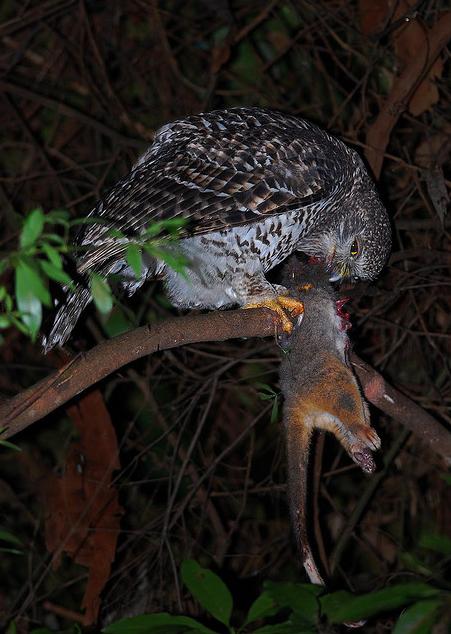
.
.
References and Further Reading:
.
[1] The Nature of Gippsland (photographic website), ‘A photo gallery featuring the natural world of Gippsland, Victoria, Australia’, Photographs by Duncan Fraser, ^ http://www.natureofgippsland.org/
[2] Birds Australia, (Special survey on Powerful Owl distribution around Sydney, 2011), ^ http://birdsinbackyards.net/surveys/powerful-owl.cfm
[3] ‘ Powerful Owl (Conservation) Action Statement, Victorian Government, Department of Sustainability and Environment, (1999), ^ http://www.dse.vic.gov.au/__data/assets/pdf_file/0019/103177/092_powerful_owl_1999.pdf [ Read More]
[4] ‘ Protecting Victoria’s Powerful Owls‘, Victorian Government, Department of Sustainability and Environment, (2001), ^ http://www.dse.vic.gov.au/__data/assets/pdf_file/0012/102144/PowerfulOwls.pdf [ Read More]
.
– end of article –
Tags: Birds Australia, Conservation through Knowledge, Forest Owls, hollow-bearing trees, old growth, Otway Ranges, Powerful Owl, Sooty Owl, South Gippsland
Posted in 07 Habitat Conservation!, Gippsland (AU), Otway Ranges (AU), Owls, Threats from Bushfire, Threats from Deforestation | No Comments »
Add this post to Del.icio.us - Digg
Saturday, August 27th, 2011
The following ultra-short article was initially published by Tigerquoll on CanDoBetter.net 20090507 under the title: ‘Premier John Brumby – a man of principle, a ‘year of action’ logging Old Growth at Bungewarr Creek‘
.
Senseless slaughter of Victoria’s Old Growth..another Brumby legacy for Victoria
29 April, 2009:
The result of senseless logging at iconic Bungewarr Creek, far East Gippsland. Loggers have desperately chainsawed magnificent stands of ancient Australian Eucalypts along Bungewarr Creek in East Gippsland as the woodchips, allowing our natural heritage to be sold out to the Japanese for a despicable $2.50 per tonne!
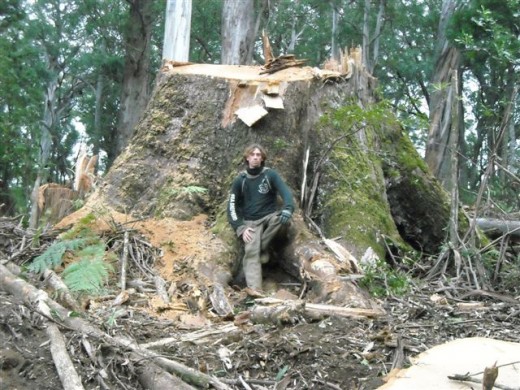
“Two protesters are ‘flying’ a platform located thirty metres up in the tree canopy”.. “this platform is cabled off to four logging machines, immobilizing them.”
First blockaded in 1994, Old Growth at Bungewarr Creek has been targeted by loggers ever since. Premier John Brumby simply cannot be trusted with Victoria’s natural heritage.
.
.
Subsequent Comments:
.
‘Sell the loggers not the logs’
On May 7th, 2009 Sheila Newman replied:
Maybe these stooges for big companies would get more money selling the loggers?
Sheila Newman, population sociologist
.
.
‘Rampant materialism and environmental destruction!’
On May 7th, 2009 Vivienne replied:
About 90% of what comes out of our old-growth forests ends up as woodchips to make paper, the majority of which is sent overseas. The “management plan” for Tasmania’s Upper Florentine Valley means a growing logging industry for wood chips, with a current price a mere $2.50 per tonne!
Despite the area being surrounded by mountains of the Tasmanian World Heritage Area, the Colonial ignorance of slash and conquer the bush has changed little since the last Tasmanian Tiger was captured there in the 1933.
All this so-called “sustainable forest management” is just thinly disguised eco-destruction by Tasmania’s logging industry.
We are bombarded with ecologically “friendly”, “sustainable” and “green” language, but the euphemisms are totally contrary to everything they claim!
We are encouraged to avoid plastic bags, turn off power when it is not needed, use energy-friendly light bulbs, save water, use public transport, but the benefits of these actions belie the fact that our governments continue to support the large polluters and industries that are adding to climate change and conservation threats!
Our leaders must be held accountable the rampant materialism and environmental destruction that our nation is succumbing to.
.
.
‘Logging contracter attacks Bungewarr protesters’
On May 9th, 2009 jim barton replied:
i have lost several thousand dollars in income due to the pathetic protests the greens have undertaken over the last 2 weeks in the bungewarr area. If you have a problem take it up with the state government directly or the vic forests office. No one will ever take you seriously while you are illegally chained to a machine or strung up a tree stopping the people who are there to make money to feed our familys. Do you honestly think the state government gives a shit while you are taking this sort of illegal action? The only people losing out are the loggers by taking away a slab of our income, the easily led pawns the greens send in to the protests that come out feeling like heroes but now have a criminal record for life. Also not to mention the tens of thousands of tax payer dollars that get spent on the police rescue squad coming from melbourne just to release the protesters and also the local police time wasted. Start using your brains and be a little more democratic and also start telling people the truth about our logging practices instead of just the lies you make up to sway the public to your way of thinking. Old growth forest dosn’t absorb carbon dioxide like you say so if you want to get technical we can say that we are helping climate change by replacing it with smaller re growth that with filter the atmosphere a lot more efficiently. This is a saw log driven industry, the pulp that goes for wood chips is what is left over from the tree after the saw log has been taken. Stop the lies and the pathetic protests because no one listens when you go about it in this way. Your protests are just an excuse for camping up the bush smoking dope, dancing around a fire by night, then during the day trying to fighting for a cause that not that many of them really know that much about.
.
.
‘State Government does not listen to decent protests!’
On May 9th, 2009 Jose replied:
Extreme protests are because our State Government is only interested in money and the votes of businesses, and jobs for forest workers. Extreme protests gets the public and the media’s attention. The income of loggers is a minor and short-term affair. These old-growth forests and trees have been here since Columbus discovered America, or before! They have TIME and GREATNESS on their side, and these stalwarts stand as sentinels against the wreckage that humans in power want to inflict on them, for a paltry $2.50 per tonne! They store massive amounts of carbon, and chopping them down is environmental vandalism. Get a job, Jim Barton! Nobody accepts the green-washing bulls**t our State government comes out with! They are all lies.
.
.
‘VicForests no different to Indonesian Timber Mafia’
On May 11th, 2009 Tigerquoll replied:
Illegal logging involves “wood harvesting, processing and trade that do not conform to law. Illegalities occur right through the chain from source to consumer, the harvesting procedure itself may be illegal, including corrupt means to gain access to forests, extraction without permission or from a protected area, cutting of protected species or extraction of timber in excess of agreed limits. Illegalities may also occur during transport, including illegal processing and export as well as mis-declaration to customs, before the timber enters the legal market.”
Other examples of illegal logging are:
* Under-reporting harvest volumes and tax payable
* Ignoring selective cutting guidelines
* Harvesting outside concession boundaries
* Falsifying log transport documents
* Accepting falsified log transport documents
Timber can also be considered illegal if the plantations are not properly managed.
This includes:
* Clear-cutting natural forest, then failing to replant
* Not planting at rates required to maintain long-term production
* Replanting with low-quality species
* Replanting at low density.”
SOURCE: http://www.abc.net.au/4corners/content/2002/timber_mafia/resources/resources_illegal_logging.htm
So perhaps Jim Barton can explain the forest impact difference between VicForests endorsed slaughter of Australia’s heritage old-growth at Bungywarr Creek and at Brown Mountain in East Gippsland and what the Indonesia’s Timber Mafia are doing?
.
.
‘More Lies’
On May 12th, 2009 jim barton replied:
Righto jose and tigerquoll lets get a few things straight. first and foremost, i have a job. i am a logger currently logging the bungewarr creek area incase you didn’t read my first piece properly. Secondly, tigerquolls new name is now guinea pig because thats what he looked and sounded like when he was running back for cover into the bush at last weeks tax payer funded protest when we wanted to talk to him. It is bullshit for you dole bludgers to say that loggers incomes are not an important issue when it comes to this arguement. That’s rich considering most of the protestors don’t have jobs and live off the money i pay in tax every week, therefor you are living off the tax money earned through logging old growth forests and that alone increases your carbon foot print when you trace it back! Like it or not the logging practices we undertake are as much as you may dislike the idea, legal. You may need a little thing the police call evidence if you want to go throwing unproven and rediculous claims at us. You can check every single log docket, boundary marker and all other relevant paperwork if you like. All you will find is a legal harvesting procedure that has complied with the legal requirements and documentation that vic forests and our state government has specified, planned and employed us under and therefor endorsed. You can throw your big words, lies and acusations around all you like but at the end of the day no laws are being broken apart from the ones you break by trespassing into a public safety area and holting work for a few hours. like i have said everyone is entitled to an opinion, maybe you need to voice yours through the proper authorities. Maybe then people will listen because illegal action will never conquer legal works. By the way, old growth trees have been proven not to produce oxygen after a certain age and also stop absorbing carbon dioxide. look it up. We do not falsify log dockets as that is what we are payed by. We do not underreport the amount of timber harvested for tax reasons as we are liable to penalties from vic forests if we do not cut the contracted volume of wood. We do not harvest outside boundaries as that can lead to penalties that in tern end up costing us money. Vic forests and the dse burn the finnished coupes to stimulate seed germination and growth (replanting). Areas are regenerated at rates to ensure that the area is sufficient for the next round of log harvesting. Finally, the correct species are replanted at the correct density to ensure the bush grows back to meet harvesting, legal and environmental standards. And to your final question guinea pig, our logging practices are not illegal due to the fact that the people in our crew comply with australias rules and regulations on the correct procedures for timber harvesting. Indonesias logging is illegal due to the fact that they enter an area to take timber without the correct permits and by buying the governments silence through kick backs from the profits of these illegal activities. Logging old growth is only illegal in your minds because you let emotion and centiment cloud your already hazey vision and it is a last desperate stab to try and lock more bush into national park. I Hope your all warm in your wooden houses tonight, on your cleared land to make way for that house and in your wooden bed and i hope that soft toilet paper that came from those trees dosn’t scratch your ass when this reply gives you all the shits!
.
.
‘Logging subsidised by tax-payer’
On May 13th, 2009 Anonymous replied:
You would have to be blind not to see that your line of work is unsustainable. That means that it costs more than it produces financially (the community subsidises logging). Do us all a favour and get a real job, or go on the dole and stop costing us all more than money.
.
.
‘Proud logger with job recycles but is realistic’
On May 13th, 2009 Jim Barton replied:
Thats the best you can come up with? Show me facts and figures on much it subsidises actual harvesting procedures.
Now if it is so unsustainable why are we logging areas that have been logged 2, 3 and up to 4 times over the last 100 years. Going on the dole would be the easy way out, wouldn’t it gutless anonymous? That is why all you loser protestors are putting your hands out every week. If you really care about the environment get out there and start working towards reducing wild dog numbers, helping to erradicate feral cats and why don’t you do something about the introduced vines that are strangling the native forests to death. The vines are spread through water ways that usually start their journey from up in the national parks that you lot won’t let anyone into to even maintain.
If you new anything about what you are talking about you would see this every time you are heading up the combienbar road dodging stubbies on your way to another pointless protest at bungywarr. But it is just easier to throw empty accusations once again without concrete evidence at the people who actually work for a living to feed their families instead of relying on someone else to feed them. I would like to say however, thank you to the person/s running this web site who have let me have a say on this subject. The greens have a terrible history of twisting what actually happens into a tangled web of what they think the public should hear, even as made up as a lot of it is. A healthy discussion is good for both sides, but eventually you will see the the country cannot survive on beautiful views, love and goodwill. unfortunately money makes the world go round and it is far to late to change that. Even climate change is a money making lie.
The earth has been changing temperature for millions of years and unfortunately buying a hybrid car and some solar panels is not going to make a lick of difference. To those who doubt my thoughts, show us all some hard evidence over the last million years of the temperature difference to now. As much as you may hate the idea the earth is undergoing a natural process that no one can control. Why i seem to recall a history lesson at school that showed tasmania, the mainland and indonesia was all one continent. With rising sea levels we now have more continents than we did millions of years ago and the sea will continue to rise no matter what we do. It is clearly a scare tactic to sway voters and the general public.
I am not a complete monster i still recycle and don’t litter but we have to be realistic.
.
.
‘National Association of Forest Industries (NAFI)’
On May 14th, 2009 Tigerquoll replied:
NAFI (or perhaps ‘Not Another Freakin Import’ provides a chainsaw scream for Australia’s scarce and depleting forests. Japanese woodchippers rape Aussie forests only to import A4 paper back to us at a profit. Aren’t we NAFI suckers?
NAFI is committed to ensuring clear fell logging and woodchipping of old growth has strong representation in political and public engagement to ensure this desperate slaughtering is supported in order to achieve the best possible outcome for NAFI and short contract loggers with no future prospects.
Australia’s forest industries, made up of remnant old growth habitat, plantations and any outlying unoccupied timber houses on the edge of towns, offer significant benefits for NAFI and no-neck loggers with no future prospects. By the year 2020 forest industries are projected to contribute:
* 16,000 short term forestry contracts and base pay with no security, no annual leave and no sick leave
* 81 million tonnes of Australian native forests sold out to Mitsui (the Japanese)
* $19 billion of Australia’s native farm sold out to the Japanese woodchippers – who have the hide profit from selling back to Australia white shiny A4 photocopy paper.
And so how is the multinational raper of Gippsland forests, Japanese Sumitomo Mitsui fairing these days? Well as at 10th April 2009, Sumitomo Mitsui reported its largest loss in six years and has desperately proposed to raise 800 billion yen in public offering.
Gippsland loggers have become losers in every sense. Contract logging to feed Jap woodchippers may pay the rent for a few months, but forget supporting a family or paying a mortgage! How many forestry workers called into the CES since the start of 2009?
.
.
‘Logging is not sustainable’
On May 14th, 2009 Vivienne replied:
Yes, you have a job! The point is , it is a dead-end type of job if you must continually destroy the habitat and ecosystems that support life. Most of our ancient forests end up at woodchips, for $2.50 per tonne! Nobody here is “putting their hands out”, but the logging industry should not be immune from retrenchment like other industries. You are right about other issues, about rubbish, feral animals and weeds. Retrenched loggers should be part of a new industry of “green” jobs of managing our native forests. There is so much good that could be done, as you have mentioned! While writing this, kangaroos are being massacred in Canberra as being “environmental threats”, but the real threats are humans, and the greed for profits! I think you have a conflict of interests with your source of income. The Government must take most of the blame for bending to these industries to get the rural votes. Our government cannot and will not address climate change because it is contrary to the growth mentality they are addicted to. Our materialistic greed is escalating, I believe, because our leaders know that our planet as such does not have another millenium left!
.
.
‘Earth is undergoing a natural process that no one can control’
On May 14th, 2009 Jose replied:
Yes, Jim Barton, the earth is undergoing a natural process that no one can control. There are things we can’t control, but there are also things we can! The massive plundering of our planet to accummulate riches and exports for continual growth is something we can control, if we get rid of self-interests and greed. Gaia will continue, the rock that rotates around the Sun, but it may not take kindly to the human “virus” it is infected with! Stephen Hawkings said humans were a bit of biological “scum” on a medium sized planet. We should not take our only home for granted! We do not have another to exploit! Our ecology is finite and so is Earth.
.
.
‘Twisting numbers into lies’
On May 15th, 2009 jim barton replied:
$2.50 a ton is not quite the truth. $2.50 a ton is what a machine operator is paid. You keep saying that wood chips are sold for $2.50 a ton, so show me a genuine document that states the chips are going for that price. $2.50 is a tonnage rate for being loaded onto the truck so technically they can’t be sent for that price. So if they are fallen for $3.50 a ton, snigged for $2.00 a ton and loaded for $2.00 ton, then the mills would have gone broke years ago wouldn’t they? Then you have the transport costs i believe that this is proof enough that you are scaring people again with more unproven lies. Yeh they are being loaded onto the truck for that price but no way sold for it.
.
.
‘Chainsaw operator should get a proper job that creates wealth’
On October 13th, 2009 Rousey replied:
I reckon that gutless whinging chainsaw operator or truck driver or whatever he is should stop taking subsidies and handouts from the government (Vicforests – never made a profit – any real company and you would have been out of a job years ago), get an education and get a proper job. Or at least stand up for something he believes. Other than the front bar of the pub.
.
.
‘These old trees do not have a monetary value!’
On October 13th, 2009 ecoEngine replied:
These trees are up to 600 years old. Their value is ecological and intrinsic. No value in $$ can justify their destruction. Income and jobs are temporal and temporary. We don’t chop up our houses when we need firewood. Destroying these heritage level trees, and protection from climate change, cannot be justified for whatever value! They are PRICELESS so disputing over dollars is irrelevant.
.
– end of article –
Tags: Brown Mountain, Bungewarr Creek, East Gippsland, Indonesia's Timber Mafia, old growth, Premier John Brumby, proud logger, save our forests, tigerquoll, VicForests, woodchip
Posted in Gippsland (AU), Threats from Deforestation | No Comments »
Add this post to Del.icio.us - Digg
Friday, August 26th, 2011
 Who does one believe?… Who does one believe?…
Greenwash Tick
.
.
.
Tuesday 23-Aug-2011:
‘Paper manufacturer loses green credentials’
by Liz Hobday, ABC News, 20110823, ^http://www.abc.net.au/news/2011-08-23/paper-manufacturer-loses-green-credentials/2851982/?site=melbourne, accessed 20110825]
.
The Wilderness Society says Australian Paper cannot meet environmental standards. The manufacturer of Reflex paper has lost part of its international environmental certification, after withdrawing from an audit of its wood supplies.

The Forest Stewardship Council was auditing Australian Paper, to check that the wood used to make Reflex paper is not sourced from high conservation value forests.
Luke Chamberlain from the Wilderness Society says the company withdrew from the process, because it cannot meet environmental standards.
“The makers of Reflex paper get their wood from the Victorian State Government native forest logging arm VicForests,” he said.
 “VicForests log in endangered species habitat. They log old growth forests in East Gippsland and the central highlands” “VicForests log in endangered species habitat. They log old growth forests in East Gippsland and the central highlands”
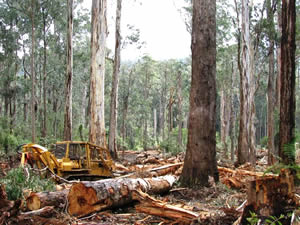
Australian Paper says its products are not sourced from high conservations value forests threatened by logging.
Shaun Scallan from Australian Paper says they withdrew because the audit process changed while it was underway.
“We pulled out because of a change in the definition of part of the standard late in the piece, which did not allow us enough time to then satisfy that changed definition,” he said.
.
.
Meanwhile the same Shaun Scallan of Australian Paper just the day prior on Monday 22 August 2011 posts his media release:
.
‘Australian Paper retains FSC Chain of Custody Certification’…?
by Shaun Scallan, Australian Paper, 20110822, ^http://australianpaper.com.au/media/2478/AP%20FSC%20audit%20release%20FINAL%20Aug%2022_2011.pdf, accessed 20110825
.
‘Australian Paper has successfully retained Forest Stewardship Council (FSC) Chain of Custody certification (FSC-C002059) in its latest audit. Auditor Rainforest Alliance confirmed that under the certification Australian Paper may continue to produce FSC-certified product based on sourcing of material from FSC-certified operations and recycled content, as allowed under the FSC rules for Mixed and Recycled product.
.
“We are pleased to have retained our FSC Chain of Custody certification,” Australian Paper CEO Mr Jim Henneberry said.
“Australian Paper has held Chain of Custody certification since 2006. However, we have decided to remove the Controlled Wood component from our certification at this time as there has been uncertainty around the interpretation of key elements of the standards.”
.
“Advice received by Rainforest Alliance from FSC International around the interpretation of the Standard was received after the physical audit had been completed. This left insufficient time for us to address and so we elected to withdraw Controlled Wood from our certification.” Mr Henneberry said.
.
Australian Paper remains committed to ensuring that fibre supplies come from internationally recognised, third party certified sources and also regards the Australian Forestry Standard and PEFC as benchmark certifications under this policy. The majority of wood supplied to Australian Paper is certified to the Australian Forestry Standard.
.
“We are also continuing to consult with a wide range of stakeholders as part of our Future Fibre Strategy review,” Mr Henneberry said.
“It is vital that we achieve the best balance between the environment, the health of regional communities and our ongoing competitiveness. We look forward to sharing outcomes from this review in due course.”
.
.
Meanwhile, we have the boss of Nippon Paper (the Japanese company that owns the misnomer ‘Australian Paper’) declaring Nippon Paper is going gang-busters to become a top global pulp and paper company…(at any cost?)
 ‘Since I was appointed president of Nippon Paper Group, Inc. in 2008, I have been pursuing “growth-oriented management.” This means exploring every possibility with a consistently positive stance, actively seizing opportunities, achieving the growth needed to become one of the top pulp and paper companies worldwide, as set out in the Group Vision 2015, and developing corporate value that meets the expectations of all stakeholders.’ ~ President of Nippon Paper Group, Yoshio Haga. [Source: ^http://www.np-g.com/e/about/president.html] ‘Since I was appointed president of Nippon Paper Group, Inc. in 2008, I have been pursuing “growth-oriented management.” This means exploring every possibility with a consistently positive stance, actively seizing opportunities, achieving the growth needed to become one of the top pulp and paper companies worldwide, as set out in the Group Vision 2015, and developing corporate value that meets the expectations of all stakeholders.’ ~ President of Nippon Paper Group, Yoshio Haga. [Source: ^http://www.np-g.com/e/about/president.html]
 . .
.
Meanwhile, the stated Charter of Nippon Paper Group includes:
.
‘6. Active involvement with environmental issues assures that…’
.
- ‘We shall promote afforestation projects, to create and make effective use of sustainable forest resources.’
- ‘We shall promote energy conservation, the use of wastepaper and other measures to effectively use resources that are limited in quantity.’
- ‘We shall manage and reduce all types of discharge and waste generated in the course of corporate activities.’
- ‘We shall research and develop manufacturing technologies, and products and services that are in harmony with the environment.’
.
[Source: ^http://www.np-g.com/e/about/charter.html#shead2]
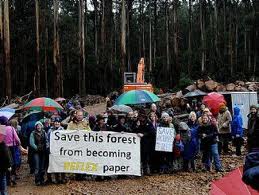
Editor: It is suspicious when a Japanese company is more than content to log and irrevocably destroy another country’s old growth forests, while Japan’s own old growth forests around Mt Fuji remain sacrosanct.
‘In spite of the abundant natural resources, logging is not commonly practiced in the forests of Japan. Japan Forests are venerated and protected since they provide essential soil cover and help in water conservation. All Species are encouraged to grow in the Forests in Japan , from the broad-leaved deciduous to the evergreen coniferous types. There are also many forests which grow near volcanic areas, destroyed and then rejuvenated every time an eruption occurs. The Aokigahara Forest at the base of Mount Fuji is one such forest. Locals as well as tourist camp, trek and hike through these dense forests of Japan to explore their unusual natural beauty.
‘Some Japan Forests are designated as Sacred Forests . These forests generally contain an ancient religious Shrine, usually worshiping the Shinto religion and are protected from trespassing and destruction. These forest shrines are still venerated as national treasures.
.
Some of the sacred forests in Japan are-
- The Forest of the Yahiko Jinja has many trees like the Cedar, Cypress and Oaks. The Shrine has a sacred Chinquapin tree as well.
- The Forest of Atsuta Jinja is an important Shinto Shrine, housing one the three important Shinto relics – the holy sword of Kusanagi-no-tsurugi. The forest has evergreens like the Japanese Camellia Sakaki, camphor trees, Ilex and Japanese Honeysuckle.
- The Forest of Kashima Jingu has over 800 species of trees like varieties of Cedar, Fir and Oak. The Kashima Jingu is an important shrine of the Kanto Area. The forest has been designated as a Wildlife Protection area for the rare birds in the region.
- The Forest of Shimogamo Jinja covers over 495 hectares and has many different species of deciduous trees like the Zelkova, the Elm and the Hackberry. The Shrine itself has 53 buildings which have been designated as National Heritage Architecture.
- The Forest of the Kirishima Jingu covers and area of 887 hectares. Located near the Mount Kirishima Volcano, the forest has been destroyed and then recovered for over 60 times.
- The Forest of the Kasuga Taisha is home to the beautiful podocarpus Nagi. The forest also contains many species of evergreens and shrubs. Trees like the Kasuga, the Andromeda and the Ichii also grow there. People from all over Japan visit the venerated shrine in the quarterly pilgrimages.‘
[Source: ^http://www.mapsofworld.com/japan/japan-tourism/forests-in-japan.html]
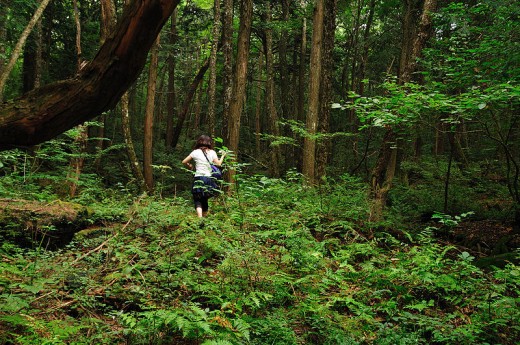 Japan’s sacred Aokigahara Forest Japan’s sacred Aokigahara Forest
.
Ethics question for Yoshio Haga (President of Nippon Paper Group):
What moral right do the Japanese have to consider their own native old growth Aokigahara Forest more sacred than Australia’s sacred native old growth forests such as those across East Gippland?
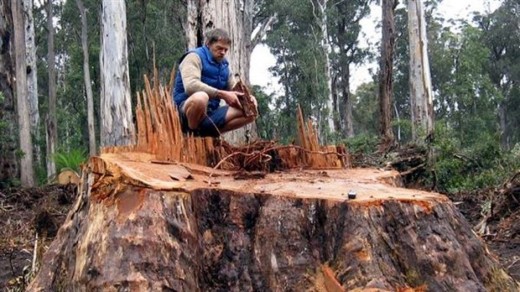 Stump of Brown Mountain’s sacred 600 year old Mountain Ash old growth tree.
It was logged by VicForests in November 2008 for Nippon Paper’s Reflex Paper. Stump of Brown Mountain’s sacred 600 year old Mountain Ash old growth tree.
It was logged by VicForests in November 2008 for Nippon Paper’s Reflex Paper.
.
.
In light of VicForests recent civil prosecution in the Victorian Supreme Court, Nippon Paper Group’s association with VicForests calls into question the reputation of Nippon Paper Group and its brand Reflex Paper:
.
‘VicForests has been stopped from harvesting certain coupes in the Brown Mountain forest in East Gippsland containing old growth forest
– habitat for rare and threatened species – until the completion of steps implementing the precautionary principle.’
.
.
.
‘Environment East Gippsland Inc v VicForests – The precautionary principle in action’
22 November 2010:
[Source: Blake Dawson (Lawyers), ‘Environment Matters’, 20111122, ^http://www.blakedawson.com/Templates/Publications/x_article_content_page.aspx?id=60457, accessed 20110825]
.
.
In Brief:.
- ‘The Victorian Supreme Court decision in Environment East Gippsland Inc v VicForests firmly embeds the approach to the precautionary principle laid down in Telstra Corporation Limited v Hornsby Shire Council (2006).’
- ‘The case makes it clear that the precautionary principle can be the subject of an enforceable obligation.’
- ‘The case also makes it clear that the precautionary principle applies both at the strategic and operational stages of a project or undertaking.’
- ‘The fact that VicForests complied with its forestry approvals was not enough to satisfy the Court that it had met its obligations with regard to the precautionary principle.’
.
‘In Environment East Gippsland Inc v VicForests [2010] VSC 335 conservation group Environment East Gippsland (EEG) won a landmark injunction against VicForests, a state-owned timber business with responsibility for commercial timber harvesting in Victoria’s state forests.
VicForests has been stopped from harvesting certain coupes in the Brown Mountain forest in East Gippsland containing old growth forest – habitat for rare and threatened species – until the completion of steps implementing the precautionary principle.
In this case, Justice Osborn of the Supreme Court of Victoria undertook a thorough analysis of the application of the precautionary principle in the context of a detailed legislative regime aimed at balancing biodiversity protection and commercial timber harvesting. The case embeds the approach to the precautionary principle laid down by Chief Justice Preston of the Land and Environment Court of New South Wales, in Telstra Corporation Limited v Hornsby Shire Council (2006) 67 NSWLR 256.’
.
The lead-up to the litigation
.
‘The Brown Mountain forests in Victoria’s East Gippsland contain old growth forests and provide habitat for rare and threatened species such as the Powerful Owl, the Spotted-tailed Quoll (mainland Australia’s largest marsupial carnivore) and the Long-footed Potoroo. However, these areas are also amongst the most productive timber harvesting forests in Victoria and play a crucial role in Victoria’s sustainable timber industry.
In 2006, the Victorian State Government committed to increasing the conservation parks and reserves within the broader Brown Mountain area. Nevertheless, in 2008 commercial logging in the Brown Mountain area began.
After numerous studies of the area indicated the presence of important threatened and rare species, EEG requested the Minister for Environment and Climate Change, Gavin Jennings, to make an interim conservation order to conserve critical habitat of the endangered Long-footed Potoroo, Spot-tailed Quoll, Sooty Owl, Powerful Owl and Orbost Spiny Crayfish at Brown Mountain. The Minister did not grant a conservation order, but instead increased the conservation area surrounding Brown Mountain.
Having failed to obtain undertakings from VicForests that it would not proceed to log the Brown Mountain coupes, EEG sought interlocutory injunctive relief. An interlocutory injunction restraining logging was granted by Justice Forrest on 14 September 2009 (see our article Environmental litigation heats up with some significant wins for public interest litigants in our 2 October 2010 edition of Environment Matters ), pending the outcome of the full proceedings before Justice Osborn in the Supreme Court of Victoria.’
.
The legislative regime
.
‘Logging of state forests in Victoria is regulated by a complex scheme of legislation, codes of practice, management plans and procedures, described by Osborn J as “labyrinthine”. The principal legislation includes the Forests Act 1958 (Vic) (Forests Act), Sustainable Forests (Timber) Act 2004 (Vic) (SFT Act), Flora and Fauna Guarantee Act 1988 (Vic) and Conservation, Forests and Lands Act 1987 (Vic).’
.
Responsibilities for timber harvesting and forestry management
.
‘VicForests is a state-owned corporation, established in 2004 to undertake the harvesting of timber in Victoria’s state forests. The Secretary to the Department of Sustainability and Environment (DSE) has overarching responsibility for managing state forests and timber harvesting within forests under the Forests Act.’
.
Legal challenge
.
‘EEG sought an injunction restraining VicForests from harvesting four coupes at Brown Mountain containing old growth forest. It also sought declarations that timber harvesting within the coupes by VicForests in accordance with the current forestry regime would be unlawful.
EEG argued that the current conservation measures for the Brown Mountain coupes did not meet the requirements of the regulatory system, which addresses the preservation of conservation values and in particular the protection of endangered species. EEG also argued that VicForests had failed to implement the precautionary principle.
VicForests took issue with EEG’s standing to sue. Further, it denied the presence of a number of endangered species and argued that the logging of the Brown Mountain coupes would take place under a legislative framework that adequately protects endangered species and would, therefore, be lawful. It also argued that it was DSE’s responsibility to stipulate any further requirements for habitat protection in accordance with the regulatory regime.’
.
EEG’s standing
.
‘Following the settled High Court authority that standing to bring such proceedings depends on the plaintiff’s “special interest” in the subject matter of the litigation (Australian Conservation Foundation v Commonwealth (2000) 200 CLR 591), Osborn J was satisfied that EEG had a relevant “special interest” because:
- EEG uses the coupes to a greater degree than the general public (for example, the group has a “Valley of the Giants Old Growth Forests Walk” through the affected coupes);
- EEG’s predecessor was involved in the consultative process for the formulation of the applicable forest management plan; and
- the government has previously recognised EEG’s status as a body representing this sector of the public interest.’
.
The precautionary principle [Ed: once again]
.
‘The VicForests case firmly embeds in Australian environmental jurisprudence the approach to the precautionary principle laid down by Chief Justice Preston of the Land and Environment Court of New South Wales, in Telstra Corporation Limited v Hornsby Shire Council (2006) 67 NSWLR 256 (Telstra). Justice Osborn’s decision in VicForests is the first Supreme Court application of the Telstra principles.
The precautionary principle is integrated throughout the Victorian forestry regime’s many instruments.
Following Preston CJ’s two-fold test in Telstra, Osborn J stressed that the precautionary principle is a test of common sense. There must be:
- a threat of serious or irreversible environmental damage; and
- scientific uncertainty as to the environmental damage.
Justice Osborn stated:
Once both of these conditions or thresholds are satisfied, a precautionary measure may be taken to avert the anticipated threat of environmental damage, but it should be proportionate … [The] degree of precaution appropriate will depend on the combined effect of the seriousness of the threat and the degree of uncertainty.
It is a “wherever practicable” test.
In practice, this meant that once the two-fold test was satisfied by EEG, VicForests had the onus of proving that the threat posed by logging the coupes did not exist or was negligible. Because it could not do this, the question then became:
- whether the threat was able to be addressed by adaptive management measures (in this case the requirement for surveys and management zone reviews); and
- whether the measure alleged to be required (here the permanent injunction against logging the coupes) was proportionate to the threat in issue.
Justice Osborn carefully examined the legislative regime and held that it is not intended that VicForests only apply the precautionary principle at the strategic planning stage:
VicForests is specifically required to apply it [the precautionary principle] having regard to the results of monitoring and research as they come to light during operations. … The requirements of the precautionary principle fall to be considered in the light of the whole of the evidence bearing on these matters as it now is and not as it was at the time VicForests completed planning.
Justice Osborn stressed, however, that the precautionary principle sits within a wider statutory regime that takes into account principles of sustainable development.
He held that unless VicForests complied with the requirements of the applicable Flora and Fauna Guarantee Act Statements and with conditions stated in the relevant allocation order (under the Forests Act) and the Timber Release Plan (under the SFT Act), logging at Brown Mountain would be unlawful.
This meant that VicForests could not rely on its current approvals to log the coupes because DSE had not, for example, changed zonings in the coupes to reflect the presence of threatened species. VicForests had an ongoing, active duty to apply the precautionary principle, which included responding to new information as it became available.
Importantly, Osborn J stressed that the precautionary principle can be the subject of an enforceable obligation.’
.
Outcome
.
‘Justice Osborn ordered that VicForests stop harvesting until various measures had been completed to respond to the detection of endangered species and to implement a precautionary approach with respect to their potential extinction. The required measures included:
- creating or amending special management zones, special protection zones and retained habitat areas to protect the Long-footed Potoroo, Greater Gliders and Yellow-bellied Gliders (as relevant);
- undertaking further surveys for the Giant Burrowing Frog, Large Brown Tree Frog and Spotted-tailed Quoll; and
- completing a current review of the Powerful Owl and Sooty Owl Management Areas,
to the satisfaction of the Director, Biodiversity Policy and Programs, DSE.
The difficulty for the Court in formulating its orders was that the power to act on the evidence of rare and endangered species and implement the required legislative and policy changes lies not with VicForests, against whom the injunction was sought, but with DSE.
Justice Osborn overcame this difficulty by stopping VicForests from logging until certain actions are undertaken, these actions being DSE responsibilities. VicForests had maintained throughout proceedings that it would comply with any changes to the regulatory regime made by DSE, and this was accepted by the Court.
.
Significance of the decision
.
This case firmly embeds the approach to the precautionary principle laid down by Chief Justice Preston in Telstra Corporation Limited v Hornsby Shire Council (2006) 67 NSWLR 256.
Justice Osborn’s decision makes it clear that:
- The precautionary principle can be the subject of an enforceable obligation.
- Parties having an obligation to apply the precautionary principle cannot demonstrate compliance with the principle solely through departmental approval of their actions or relevant approvals under the regulatory regime; the precautionary principle is an active obligation that applies throughout operations, requiring parties to respond to new information as it arises.
- The precautionary principle applies throughout all stages of operation, not just the strategic planning (or approvals) stage.
The decision has broader implications because:
- The precautionary principle is embedded in many other statutory regimes in Victoria and around Australia, apart from the Victorian legislative regime for forestry and the protection of endangered species. The decision has implications for any statutory regime in which the principle is enshrined.
- Although VicForest is a state-owned enterprise operating within a highly regulated environment, there is scope for the decision to be applied to other types of entities operating within industries where the precautionary principle is relevant.
Furthermore, a decision of the Supreme Court of Victoria has strong precedent value, and is likely to be adopted by the Supreme Courts of other States, and perhaps even higher courts or courts with federal jurisdiction.
.
Action points
.
Parties under an obligation to apply the precautionary principle need to be aware that:
- to implement the precautionary principle as per the principles laid down in Telstra, parties need to ask:
- is there a real threat of serious or irreversible damage to the environment?
- if yes, is it attended by a lack of full scientific certainty (in the sense of material uncertainty)?
- if yes, is the threat non-existent or negligible?
- if no, is the threat able to be addressed by adaptive management and is the measure alleged to be required proportionate to the threat in issue?
- the principle must be applied at both the strategic decision making stage of a project, and throughout the operational stage; and
- it may not be sufficient to simply obtain and comply with project approvals – parties need to proactively respond to new information as it arises throughout the operational stage.’
.
..
.
Further Reading:
.
[1] >Vicforests’ Ecological Genocide
.
[2] ‘Nippon buys Maryvale mill‘, by Ian McIlwraith, The Age newspaper, 20090217, ^http://www.theage.com.au/business/nippon-buys-maryvale-mill-20090216-89bu.html, accessed 20110826]
.
‘Paperlinx will take a $600 million hit on its half year results and the future of its Tasmanian operations is under review after last night unveiling the partial sale of its Australian papermaking business.
Japan’s Nippon Paper Group will buy most of Australian Paper, which includes the Maryvale pulp mill in Gippsland, for more than $700 million, including taking on attached debt and a three-year profit share agreement.
Money from the sale, expected to be completed in June, will go to reducing PaperlinX’s debt burden to about $340 million…’
[Editor: So Paperlinx was in debt to the Australian Tax Office by over a billion dollars? How can Australia’s pulp industry be profitable then?]
.
[3] Australian Paper Watch website (providing information about the logging of Victoria’s forests to make paper products such as Reflex by Nippon Paper and their ‘subsidiary’ Australian Paper), ^http://www.australianpaper.forests.org.au/
.
[4] Nippon Paper’s Maryvale Mill Upgrade, ^http://www.reflex.com.au/2008-Maryvale-Mill-Upgrade/
‘Australian Paper has a long history in the La Trobe Valley in Gippsland, Victoria, dating back to 1937 when established. Today, the Mill is Australia’s largest integrated pulp and paper operation. In response to global paper trends and changing consumer expectations for our products, Australian Paper (Nippon Paper subsidiary) embarked on a major upgrade of the Maryvale Pulp Mill in 2006 which was completed in December 2008. With an investment of $350 million, the upgrade significantly expanded the Mill’s production of bleached pulp capacity and delivered a range of safety, health and environmental benefits.’
.
[5] ‘Loggers, activists clash over forest‘, by Adam Morton, The Age newspaper, 20110817, August 17, 2011, ^http://www.theage.com.au/victoria/loggers-activists-clash-over-forest-20110816-1iwew.html
.
‘Conservationists have held up timber workers in a fiercely contested area of native forest on Melbourne’s fringe for nearly a month, chaining themselves to bulldozers and climbing trees scheduled for logging.
The protest, which has led to at least 10 arrests, is expected to reach a climax today as activists and local residents march into the logging coupe outside Toolangi in Victoria’s central highlands.
Protest organisers claim they have evidence the coupe is home to the endangered Leadbeaters Possum, which scientists say is under threat after Black Saturday bushfires wiped out up to half its habitat. But the Department of Sustainability and Environment says there has been no sign of live possums. Department spokeswoman Kim Payne said one tree in the coupe had hollows that showed evidence of possum use. That tree would be left standing, but the coupe did not meet the legal criteria of prime possum habitat and could otherwise be logged.
Sarah Rees, director of Healesville-based group My Environment, said it was cruel to think a possum could be protected by retaining a single tree while taking away the forest around it. She said logging was hurting central highlands communities.
.
”Tourism based on the state forest is far more important to the local economy than forestry and the two cannot co-exist,” she said.
The conflict over the Toolangi State Forest was the focus of a public meeting in the area late last week when logging opponents verbally clashed with forestry workers, who accused the activists of restraint of trade. One contractor said he had lost about $80,000 due to the protests.
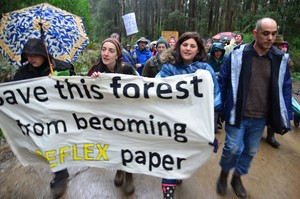
David Walsh, spokesman for state commercial timber agency VicForests, said the Toolangi protests had cost forest workers significant time. Only about a quarter of the 19-hectare coupe had been harvested. He said gates raised to ensure public safety had been damaged. ”VicForests believes these are legal harvesting operations which comply with the detailed legislative framework governing native timber harvesting in Victoria,” he said.‘
.
Editor: The legal doctrine of ‘restraint of trade’ sought to be applied in the commercial exploitation and destruction of old growth forests, is an invalid excuse. It is a contemptible euphemism for a ‘right to rape’ old growth ecology that is being contrived by commercial lawyers profiting from the exploiters ~ a case of the morally bankrupt collaborating with the damned.
[6] Ethical Paper website, ^http://www.ethicalpaper.com.au/
.
[7] My Environment website, ^http://www.myenvironment.net.au/
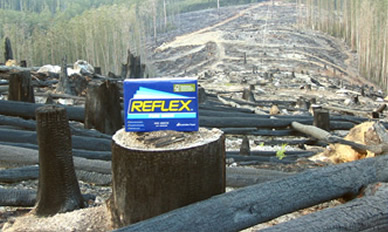
.
– end of article –
Tags: Aokigahara Forest, Atsuta Jinja, Australian Forestry Standard, Australian Paper, Chain of Custody certification, deforestation, East Gippsland, EEG, endangered species habitat, Environment East Gippsland, Environment East Gippsland Inc v VicForests, Flora and Fauna Guarantee Act, Forest Stewardship Council, Forestry Standard Certification, FSC, FSC audit process, FSC Chain of Custody Certification, FSC International, FSC-C002059, Future Fibre Strategy, Giant Burrowing Frog, Greater Glider, Greenwash Tick, Kashima Jingu, Kasuga Taisha, Kirishima Jingu, Large Brown Tree Frog, Leadbeaters Possum, Logging, Long-footed Potoroo, Maryvale Pulp Mil, My Environment, Nippon Paper Group, PEFC, Powerful Owl, precautionary principle, pulp and paper, Rainforest Alliance, Reflex Paper, restraint of trade, right to rape, sacred forest, Shimogamo Jinja, Shinto religion, Sooty Owl, The Wilderness Society, Timber Release Plan, Toolangi State Forest, TWS, VicForests, Yahiko Jinja, Yellow-bellied Glider
Posted in Gippsland (AU), Owls, Potoroos, Quolls, Reptiles, Threats from Deforestation | No Comments »
Add this post to Del.icio.us - Digg
Thursday, August 25th, 2011
 The Great Grey Owl of Lapland (Strix nebulosa) – the largest owl in existence
(click to enlarge) The Great Grey Owl of Lapland (Strix nebulosa) – the largest owl in existence
(click to enlarge)
.
‘A little knowledge is a dangerous thing‘ is a wise old proverb meaning that a small amount of knowledge can mislead people into thinking that they are more expert than they really are.
The phrase is considered originally derived from English politician and philosopher, Francis Bacon, in his literary work ‘The Essays: Of Atheism‘ of 1601, as follows:
.
“A little philosophy inclineth man’s mind to atheism; but depth in philosophy bringeth men’s minds about to religion.” [1]
.
It may generally apply quite aptly across the human species. Homo sapiens sapiens is the most intelligent species on the planet. Yet given our legacy thus far, are we really much more intelligent than any other species that exists simply to breed and perpetuate its species?
Our intelligence has enabled us to successfully breed not just for survival, but to colonise the planet like no other. Yet our intelligence can only be a little more intelligent than other species, since our breeding and colonisation has grown to such an extent that it has driven other species to extinction and has destroyed much of the planet upon which we depend. While other species have a symbiotic relationship with their environment, the extent of ecological destruction that humanity has caused and continues to cause to our host planet makes us Earth’s Pathogen. A pathogen is an agent causing disease or illness to its host, such as an organism or infectious particle capable of producing a disease in another organism. Human breeding and colonisation is extreme to the extent that it is approaching 7 billion. As we exponentially breed, colonise and destroy, we destroy our host planet.
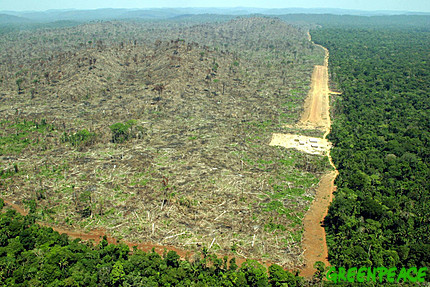
Speaking of religion, the demise and extinction of the Rapa Nui civilization on the remote Easter Island in the Pacific Ocean has become a metaphor for the self-destruction of humanity. One theory for the collapse of the Rapa Nui culture is that the Ancestor Cult that respected the dead drove the building of large stone statues (moai) to represent deified ancestors. It was believed that the living had a symbiotic relationship with the dead where the dead provided everything that the living needed (health, fertility of land and animals, fortune etc.) and the living through offerings provided the dead with a better place in the spirit world. The island’s trees were killed and used to help move these massive moai into desired position, but over time, as more moai were erected, the island’s trees were eliminated. Absolute deforestation led to the collapse of the island’s ecosystem and food supply and so to the demise of the Rapa Nui.
A second theory is that by Hunt and Lipo (2006) who found no evidence of human deforestation, or of human habitation prior to 1200. Instead, they suggest that the collapse of island society was due to the introduction of Polynesian Rats that arrived in the boats of early settlers. They hypothesize that rat population spiked at around 20 million individuals, and that these rats quickly consumed all the seeds of the native palms, leading to the collapse of the island food supply. [2]
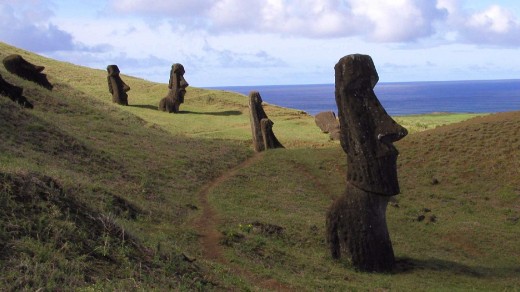 The Moai of Easter Island,
the living faces of worshipped ancestors of the Rapa Nui people
(click to enlarge) The Moai of Easter Island,
the living faces of worshipped ancestors of the Rapa Nui people
(click to enlarge)
.
.
‘Homo sapiens – time for a new name?
The following article is directly sourced from a transcript by Julian Cribb on the ABC Radio Science Show programme, which was aired 20110820 [3]
.
“It is high time the human race had a new name. The old one, Homo sapiens – wise or thinking man – has been around since 1758, and is no longer a fitting description for the creature we have become. When the Swedish father of taxonomy, Carl Linnaeus, first bestowed iti, humans no doubt seemed wise when compared with what scientists of the day knew about both people and other animals. We have since learned our behaviour is not quite as intelligent as we like to imagine, while some other animals are rather smart. In short, ours is a name which is both inaccurate and which promotes a dangerous self-delusion.
In a letter to Nature I am proposing there should be a worldwide discussion about the formal reclassification of humanity, involving both scientists and the public. The new name should reflect more truthfully the attributes and characteristics of the modern 21st century human, which are markedly different from those of 18th century ‘man’.
Consider the following: Humans are presently engaged in the greatest act of extermination of other species by a single species, probably since life on Earth began. We are destroying an estimated 30,000 species a year, a scale comparable to the greatest extinction catastrophes of the geological past.ii We currently contaminate the atmosphere with 30 billion tonnes of carbon equivalent every year.iii This risks an episode of accelerated planetary warming reaching 4-5 degrees by the end of this century and 8 degrees thereafter, a level which would severely disrupt food production.iv Estimates for the ultimate losses from 8of warming range from 50 to 90% of humanity.v
We have manufactured around 83,000 synthetic chemicalsvi, many of them toxic at some level, and some of which we inhale, ingest in food or water or absorb through the skin every day of our lives. A US study found newborn babies in that country are typically contaminated by around 200 industrial chemicals, including pesticides, dioxins and flame retardants.vii These chemicals are now found all over the planet, and we are adding hundreds of new ones, of unknown risk, every year. Yet we wonder why more people now die of cancer.
Every year we also release around 121 million tonnes of nitrogen, 10 million tonnes of phosphorus and 10 billion tonnes of CO2 into our rivers, lakes and oceans, many times the amounts recirculated by the Earth naturally. This is causing the collapse of marine and aquatic ecosystems, disrupting food chains and causing ‘dead zones’. More than 400 of these lifeless areas have been discovered in recent times.viii
We are presently losing about 1% of the world’s farming and grazing land every year. This has worsened steadily in the last 30 years, confronting us with the challenge of doubling food production in coming decades off a small fraction of today’s area. At the same time we waste a third of the world’s food.ix
Current freshwater demand from agriculture, cities and energy use will more than double by mid century, while resources in most countries – especially of groundwater – are drying up or becoming so polluted they are unusable.x
We passed peak fish in 2004xi, peak oil in 2006xii, and will encounter growing scarcities of other primary resources, including mineral nutrients, in coming decades. Yet demand for all resources, including food, minerals, energy and water, will more than double, especially in Asia.
Humanity spends $1.6 trillion a year on new weaponsxiii, but only $50 billion a year on better ways to produce food. Despite progress in arms reduction, the world still has around 20,000 nuclear warheads and at least 19 countries now have access to them or to the technology to make them.xiv
Finally, we are in the process of destroying a great many things which are real – soil, water, energy, resources, other species, our health – for the sake of a commodity that mostly exists in our imagination: money. While money has its uses as a medium for exchange, humanity is increasingly engaged in mass self-delusion as to what constitutes real wealth, as is quite clear from the current financial crisis.
All of these things carry the risk of catastrophic change to the Earth’s systems, making it difficult to justify our official sub-species name of Homo sapiens sapiens, or wise wise man. This not only looks like conceit, but sends a dangerous signal about our ability to manage what we have unleashed. A creature unable to control its own demands cannot be said to merit the descriptor ‘wise’. A creature which takes little account of the growing risks it runs through its behaviour can hardly be rated ‘thoughtful’.
The provisions of the International Code on Zoological Nomenclature provide for the re-naming of species in cases where scientific understanding of the species changes, or where it is necessary to correct an earlier error. I argue that both those situations now apply.
This is not just an issue for science; it concerns everybody. There needs to be worldwide public discussion about what is an appropriate name for our species, in the light of our present behaviour and attributes. Here are some names suggested by eminent Australian scientists. Marine scientist and author, Charlie Veron, suggests Homo finalis. Desert ecologist, Mark Stafford-Smith, proposes Homo quondam et futures – the once and future human. Spatial ecologist, Hugh Possingham, likes Homo nesciens – ignorant man. And atmospheric scientist, Barrie Pittock, suggests Homo sui deludens – self-deluding man.
Down the track we should not rule out an eventual return to the name Homo sapiens, provided we can demonstrate that we have earned it – and it is not mere flatulence, conceit or self-delusion. The wisdom to understand our real impact on the Earth and all life is the one we most need at this point in our history, in order to limit it. Now is the time humans get to earn, or lose forever, the title sapiens.”
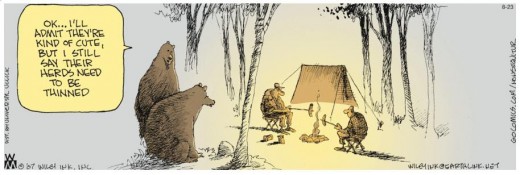 (Source: Non Sequitur – by Wiley Miller, ^http://www.gocomics.com/nonsequitur/2011/08/23) (Source: Non Sequitur – by Wiley Miller, ^http://www.gocomics.com/nonsequitur/2011/08/23)
.
.
Editor: Globally, a material difference between Humanity and other species is that we are more intelligent at doing what other species naturally do – colonising for our own self-interest. We are Homo colonus ventosa (the conceited coloniser), or simply Homo ego ruina (self-destructive Man).
If we accept that at our current stage of evolution we have a little more knowledge than other species; and that our legacy has proven thus far to be dangerous to us, other species and to the planet, then we would be wise to seek deeper knowledge of our circumstance, of our place and of other species and the planet. The test for Humanity now is to ask what would the wise do and not do? A first step in advancing our species is to recognise that we have become Earth’s Pathogen. the second step is to recognise that we don’t know the true extent of the damage we are causing to the planet and so in the face of such uncertainty, we are wise to adopt a precautionary approach. The Precautionary Principle states: ‘When an activity raises threats of harm to human health or the environment, precautionary measures should be taken even if some cause and effect relationships are not fully established scientifically. In this context the proponent of an activity, rather than the public, should bear the burden of proof. The process of applying the Precautionary Principle must be open, informed and democratic and must include potentially affected parties. It must also involve an examination of the full range of alternatives, including no action.’ [4]
.
‘We abuse land because we regard it as a commodity belonging to us. When we see land as a community to which we belong, we may begin to use it with love and respect.’
~Aldo Leopold, A Sand County Almanac (1949).
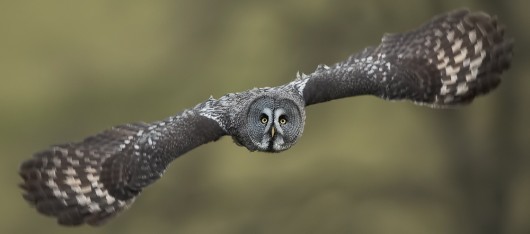 The Great Grey Owl in flight
(click to enlarge) The Great Grey Owl in flight
(click to enlarge)
.
.
References:
.
[1] ^ http://www.phrases.org.uk/meanings/a-little-knowledge-is-a-dangerous-thing.html
[2] Hunt, T. L.; Lipo, CP (2006). “Late Colonization of Easter Island”. Science 311 (5767): 1603
[3] ‘ Homo sapiens – time for a new name?‘, Julian Cribb, ^ http://www.abc.net.au/rn/scienceshow/stories/2011/3294576.htm, accessed 20110825
[4] Nancy Myers, 2004, ‘The Rise of the Precautionary Principle – A Social Movement Gathers Strength’ in  , September 2004, Vol. 25, No.9, http://multinationalmonitor.org/mm2004/09012004/september04corp1.html [> Read More]
.
– end of article –
Tags: a little knowledge is a dangerous thing, Aldo Leopold, Earth's Pathogen, Easter Island metaphor, Great Grey Owl, Homo sapiens sapiens, human pathogen, Rapa Nui
Posted in Owls, Ph05 Earth's Pathogen, Threats from Deforestation, Threats from Overpopulation | No Comments »
Add this post to Del.icio.us - Digg
Friday, August 19th, 2011
(The following article was initially posted on CanDoBetter.net by Tigerquoll on 20090426. It has since been modified.)
.
 VicForests’ neo-colonial practice of logging old growth East Gippsland forests, justifies such culling by claiming compliance with Australia’s wood production Standard AS 4708-2007. But this standard is Mein Kampf for ecological genocide of East Gippsland Forests. VicForests’ neo-colonial practice of logging old growth East Gippsland forests, justifies such culling by claiming compliance with Australia’s wood production Standard AS 4708-2007. But this standard is Mein Kampf for ecological genocide of East Gippsland Forests.
Have a read: http://www.forestrystandard.org.au/files/Standards/4708.pdf [Read the Standard]
Under this official Australian Standard that sees only the wood for the trees, it includes two criteria that serve to deliver propaganda spin respect for forest ecology. One must recognise these criteria accompanying Criterion 4—Forest management shall maintain the productive capacity of forests. Need I say more?
Forestry Propaganda Criterion #3 for instance, requires forest management to ‘protect and maintain the biological diversity of forests’. Wonderful wholesome, noble and holistic rumblings about this one – but gullibles wake! VicForests <em>Mein Kampf</em> hides the ‘ chainsaw-speak‘ in the detail:
* ‘Small-scale clearing is permitted up to a limit of 40 hectares on a single forest management unit’. ‘Conservation of threatened (including vulnerable, rare or endangered) species and ecological communities requires the forest manager to minimise adverse impacts by ensuring he/she takes into account of known information and relevant specialist advice‘. (Makes Fiji look like a democracy!)
Forestry Propaganda Criterion 5 requires forest management to maintain forest ecosystem health and vitality, yet is so vague as to allow forest ‘practices’ only to ensure that damage stays “within tolerable levels”. Does this mean one tree per hectare can be left standing or may be two?
.
Then there’s Clause 4.5.3:
‘Forest managers managing native forests shall use fire and other disturbance regimes to maintain and enhance forest ecosystem health where appropriate to the forest type or scale.’ [p.25]
.
…that is, burn and disturb native forests at will, because we argue that doing so enhances forest ecosystem health. Whoops! The wind picked up and the forest is gone; still we complied with AS 4708-2007!
Such contemptible logic would argue that a bushfire raging through a town can to it good, because eventually the town is rebuilt and the people eventually return, look at Narbethong!
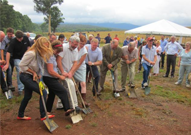
.
.
The Ferguson Tree – lest we forget
.
“The tallest tree ever properly measured was a Eucalyptus tree and was 436 feet tall. It was measured by William Ferguson on the 21st of February in 1872. Alarmingly the crown was broken off when the tree was still 1 meter thick, leading to claims that it once was up to five-hundred feet tall in one point in its lifetime.”
The length was a staggering (if true) 133 metres (436 feet) with its crown (the tree’s top) broken off!! The stump’s diameter five feet off the ground was 5.5m (18 feet) and at its broken top its diameter was still 1 metre. It is estimated that had this tree actually still been intact it would have approached 152m (500 feet) in height. The surveyor also noted numerous fallen trees in the same area over 106m (350feet) in height.
It would have been a Mountain Ash or Eucalyptus regnans. Sorry, no photo available. The legend remains only in text.
[Source: ^http://jtpredwoods12345.blogspot.com/]
.
.
‘VicForests accused of felling old-growth mountain ash’
.
[Source: Adam Morton, 20100629, The Age newspaper, ^http://www.theage.com.au/victoria/vicforests-accused-of-felling-oldgrowth-mountain-ash-20100628-zf5o.html]
.
‘The Victorian government’s forestry arm will face a legal challenge over claims it illegally logged old-growth forest and increased the risk to a threatened species.
Environmental groups accuse VicForests of felling dozens of pre-1900 ash eucalypts, breaching the Central Highlands Forest Management Plan. An impending legal case will also claim the timber agency failed to protect habitats necessary for the survival of Victoria’s threatened faunal emblem, Leadbeater’s possum.
Ecologist Jacques Cop, from consultants Acacia Environmental Group, said a survey of just one coupe near Toolangi found 31 pre-1900 ash eucalypts had been logged. Five stumps were more three metres across.
”These are trees that are 200 or 300 years old,” he said.
Mr Cop said the area should also have been protected as a Leadbeater’s possum habitat as it met the threshold of having at least 12 hollowed trees within three hectares. He said neither the state Department of Sustainability and Environment nor VicForests carried out ground surveys to check if ecological requirements were being met. Sarah Rees, president of local group My Environment, said the situation was an emergency.
’31 pre-1900 ash eucalypts had been logged’
.
“If this doesn’t stop we’re going to lose the last viable habitat for a range of different species, but Leadbeater’s possum carries the strongest case for legal protection“, she said.
The state government said it took the allegations “extremely seriously“.
Spokesman Michael Sinclair said VicForests would investigate the alleged breaches and report to the Department of Sustainability and Environment. VicForests spokesman David Walsh said the agency carried out detail planning before harvesting to ensure it acted within the law and had offered to meet local residents to better understand their concerns.
“No old-growth forest is harvested by VicForests in Victoria’s central highlands region”, he said.
The legal case, being prepared on behalf of a group called the Flora and Fauna Research Collective, comes amid community concern about the scale of logging in the central highlands after the Black Saturday bushfires.
The Wilderness Society said that evidence supporting the latest claims showed illegal logging of native forests was rife under the state government’s watch.
A separate allegation of illegal logging at Brown Mountain, in east Gippsland, is the subject of a pending Supreme Court judgment.
“Premier Brumby must act now to end VicForests’ woodchip rampage in Victoria’s magnificent native forests“, said Wilderness Society spokesman Luke Chamberlain.

Sarah Rees at the base of an ancient mountain ash spared the chainsaw but killed during a clean-up fire near Toolangi.
She says the present situation is an emergency.
Photo: John Woudstra
.
.
 VicForests motto reads: “Victorian Timber: beautiful, natural, functional” VicForests motto reads: “Victorian Timber: beautiful, natural, functional”
[SOURCE: http://www.vicforests.com.au/]
.
..in lay terms, this means kill beautiful natural specimens – they make the finest woodchips for reliable REFLEX office paper.
.
.
VICFORESTS: “VicForests employs over 140 staff across 10 Victorian sites located in Melbourne, Healesville and regional areas of Central Highlands and East Gippsland.
We have a variety of exciting career opportunities available – our Foresters specialise in tactical and operational planning, roading, harvesting and contract management, silviculture and native forest regeneration.
Other career paths include customer management, resource and business analysts, safety and risk, operational audit, forest scientists and product delivery.”
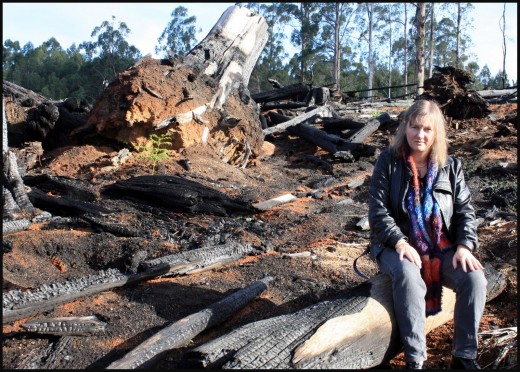
VICFORESTS: “We also employ staff in non-forestry roles including IT, HR, communications, finance, administration and customer service. A significant proportion of our staff and contractors are also involved with fire-fighting efforts each year.
VicForests is focused on investing in its employees through training, development, and providing career opportunities.”
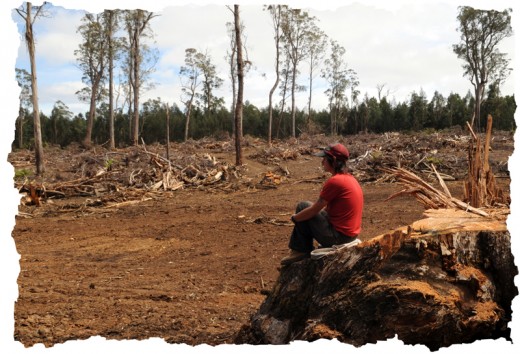
VICFORESTS: “We look for dynamic people who have a strong desire to be part of an organisation that strives to achieve success through implementing excellent and innovative business and timber industry practices for our customers and stakeholders.
Contributing to the timber industry is something that VicForests and its staff are proud of.”
.
[Source: ^http://vicforests.logic1.com.au/employment.htm, accessed 20110819]
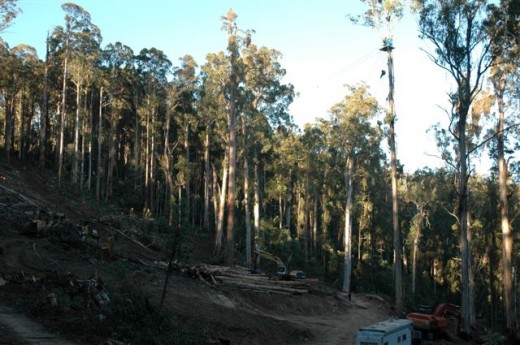 Vicforests’ coup at Stoney Creek
East Gippsland 2009 Vicforests’ coup at Stoney Creek
East Gippsland 2009
.
.
‘VicForests’ 2009 Annual Report reveals $5.1 million loss’
.
‘VicForests’ 2009 Annual Report has once again revealed that the logging agency continues to waste taxpayer millions of dollars sending our forests to the woodchip mills. The report shows that VicForests has posted a loss this year of $5.1 million. This is on top of last year posting a tiny profit after receiving a $5 million lifeline from government, and a loss the previous year.
 Woodchip train makes its way to Midways, Geelong (2009) for as little as $2.50 per tonne.
Photo: Wilderness Society Collection
Woodchip train makes its way to Midways, Geelong (2009) for as little as $2.50 per tonne.
Photo: Wilderness Society Collection
.
‘Whilst VicForests squanders Victorian taxpayer’s hard earned money, woodchipping and paper companies continue to post handsome profits. Whilst we don’t yet know how much they will make for 2009, South East Fibre Exports, a wholly owned subsidiary of Japanese paper giant, Nippon Paper, last year made over $10 million profit. They woodchipped approximately half a million tonnes of Victoria’s native forests, and this year paid as little as $2.50 per tonne for them.
Another giant company, Australian Paper, which makes Reflex papers, is VicForests’ largest single customer and was recently purchased for around $700 million by Nippon Paper. The $5.1 million loss is on top of an extra $1.3 million handout for bushfire recovery and does not include the massive $29 million royalty that it has failed to hand over to the state government who, along with the Victorian public, own these forests.’
.
[Source: ^http://www.wilderness.org.au/campaigns/forests/vicforests-2009-annual-report-reveals-5.1-million-loss]
 A tombstone of the once impenetrable forest.
A Mountain Ash stump alongside an old forestry track in Balnook, Gippsland.
Note the notches cut in the trunk for standing planks to cut the tree down by axe!
A tombstone of the once impenetrable forest.
A Mountain Ash stump alongside an old forestry track in Balnook, Gippsland.
Note the notches cut in the trunk for standing planks to cut the tree down by axe!
.
.
Reflex Office Paper
‘Paperlinx’s giant Maryvale mill located in Victoria’s Central Highlands is the largest pulp and paper making complex in Australia, consuming 475,000 cubic metres of eucalyptus forest per annum (RFA, 1998).
‘In July 2006, the Maryvale Mill received Forest Stewardship Council (FSC) Chain of Custody Certification for A4 Reflex products manufactured on its Number 3 and Number 5 Paper Machines. Paperlinx has been proudly promoting its environmental credentials ever since (as well as before).
Paperlinx is Australia’s only office paper producer. Its flagship product REFLEX copypaper is 100 per cent virgin native forest. Woodchips to make the paper are sourced from areas including rainforest, old growth forest, endangered species habitat and Melbourne’s largest water source, the Thompson Dam catchment area. Woodchips are also sourced from the Strzelecki Rainforest Reserve, an area that was promised protection by the state government due to its high conservation value.
These areas can be visited and viewed first hand, or determined by satelite image maps which show different forest types (such as rainforest as compared to woodlands) and where logging is occuring. The fact that Paperlinx gained FSC accreditation has raised concerns amoung environment groups who have been campaigning for the protection of these areas for over a decade.
Reflex Recycled Paper
Paperlinx has recently released a brand of paper wrapped in green packaging labelled Recycled. Fifty percent of REFLEX Recycled paper is made from pre-consumer waste (printers’ offcuts), but no genuine post-consumer (eg kerbside collected) recycled papers. The other fifty percent is from the same virgin native forest as stated above.
According to The Wilderness Society Paperlinx has the resources and technology to make use of alternative sources such as plantations and recycled paper, but doesn’t do so as it receives state-owned native forest logs for a significantly lower cost than plantation logs.
Due to the lack of accurate information reaching the public, an alliance of Australia’s peak environment groups including The Wilderness Society, Environment Victoria, Friends of the Earth and the Australian Conservation Foundation released a flier in 2004 urging people to boycott REFLEX paper and listing alternatives.
THE ALTERNATIVE
There is no 100 per cent recycled office paper manufactured in Australia. Brands made overseas that are available in Australia include Evolve, Canon 100 and Fuji Xerox Recycled Supreme.’
[Source: ‘Reflex Office Paper‘, Greenwash .org ^http://www.greenwashreport.org/node/41 ]
.
‘Always rely on Reflex to woodchip old growth‘
  Scott Gentle from the Victorian Forest Contractors Association
questions the logic of the Yarra Ranges council’s decision to boycott Reflex paper products.
[Source: ^http://free-press-leader.whereilive.com.au/news/story/paper-ban-anger/] Scott Gentle from the Victorian Forest Contractors Association
questions the logic of the Yarra Ranges council’s decision to boycott Reflex paper products.
[Source: ^http://free-press-leader.whereilive.com.au/news/story/paper-ban-anger/]
.
.
Further Reading:
.
[1] ‘Brown Mountain Rape’, ^http://candobetter.net/node/1005
[2] Ethical Paper, ^http://www.ethicalpaper.com.au/
[3] Save Sylvia Creek Toolangi, ^http://www.myenvironment.net.au/index.php/me/Community/SAVE-Sylvia-Creek-Toolangi
[4] Brown Mountain – final court orders, ^http://www.eastgippsland.net.au/?q=campaigns/brown_mountain/whats_new
[5] Reflex Office Paper, ^http://www.greenwashreport.org/node/41
[6] Victorian Supreme Court Decision: ‘Environment East Gippsland Inc v VicForests [2010] VSC 335 (11 August 2010)’, ^http://www.austlii.edu.au/au/cases/vic/VSC/2010/335.html
.
.
– end of article –
Tags: Acacia Environmental Group, Australian Paper, Brown Mountain, chainsaw-speak, East Gippsland logging, ecological genocide, Ferguson Tree, Forestry Standard 4708, Forestry Standard Certification, Gippsland Giants, illegal logging, Leadbeater’s possum, Logging, Nippon Paper Group, Reflex Paper, Toolangi, VicForests
Posted in Gippsland (AU), Possums and Gliders, Threats from Deforestation | No Comments »
Add this post to Del.icio.us - Digg
Thursday, August 18th, 2011
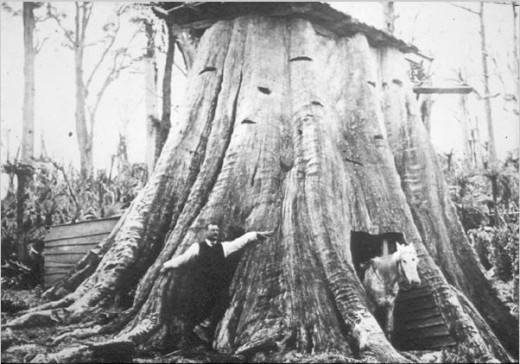
Gippsland Giants
by John Stephens
.
‘Do you know that possibly the biggest living thing in the world once lived in Gippsland and that its descendents still live here? No it’s not the blue whale, nor the giant kangaroo or the thylacine or even the black panther, it’s Eycalyptus regnans, the Victorian or Mountain Ash! These trees are the world’s tallest hardwoods and the tallest flowering plants.
The trees in the Tara Bulga Park are certainly imposing and of an impressive size, somewhere in the vicinity of sixty metres tall! You’ve seen Mountain Ash on drives or walks throughout the Strzelecki Ranges or the Baw Baw plateau. But I’m sorry to tell you, that you haven’t seen a real Mountain Ash and are most unlikely to ever see one. Of course I am talking about specimens that did exist before we “harvested” them. I don’t consider myself a “greenie” however I cannot be anything but amazed at the destructiveness of the human species.
During my “younger days” I spent many an enjoyable hour riding a motorcycle around the top end of Merriman and Traralgon Creeks. One of my greatest memories was seeing the stumps of some huge trees that had been logged, somewhere on the western side of the Merriman Creek headwaters, and imagining what they must have looked like in their original grandeur. I also came across the huge “historic” tree stumps at Mt Tassie and as many others have, I marvelled at their massive girth.
The Ada Tree near Powelltown, which is estimated to have existed for over three hundred years, is possibly the largest remaining specimen in Victoria. It has been preserved and is estimated to stand at about 76 metres, although it was significantly taller. The crown has been blown away either in a storm or struck by lightning, meaning the tree may have reached a height in the vicinity of 120 metres. Another giant, The Big Tree, in the Cumberland Tall Trees Reserve is 82 metres tall, but was 92 metres before a storm destroyed the top in 1959. What stuns me, is that if I imagine one of these trees to be the imposing Eucalyptus obliqua in the top corner of my block and it fell along the fence line, it would stretch the full 83 metres of the block!
“The Baron” height – 66m, girth 14.5m
 |
Near Narbethong – 91m, girth 7.7m
 |
I understand that to our pioneers the supply of forest, trees and timber seemed endless and they had a need to provide land for agriculture and development. However I do not understand their need to destroy everything that they saw as a challenge. Why did they have to destroy the Centennial Exhibition Tree that had stood in the Menzies Creek forest for hundreds of years until its demise in 1888? It was measured at over 122 metres after being felled and was reassembled for display at the exhibition in Melbourne. Surely it would have been better to take parties to visit the living tree in its natural surrounds and glory.
Part of an article written by Paul Edwards cleverly conveys what most of us feel about these giants – “When a tree gets old and tumbles, it becomes a noble thing — a fallen tree — but when it is cut down it turns into a log”. The best way to measure a tree is of course to do so when it has been cut down. This is essentially what happened to another giant at Thorpdale. It was felled in the1880s, measured by the surveyor G Cornthwaite, and found to have been 114.3 metres tall. I believe all that remains to signify the existence of this giant is a sign on the roadside indicating where it once stood, definitely far less impressive than the tree itself.
Some of these old trees must have been even more impressive. A 66 metre tall tree in Sassafras Gully in the Dandenongs and known as “The Baron” had a girth of 14.5 metres. The Bulga Stump, which was destroyed in the 1939 bushfires, famous for its huge girth of 34 metres! The Furmstons or Mueller Tree near Mt Monda was only 60 metres high when it fell in 1998 although it was estimated to be well over 100 metres when it was first discovered in the late nineteenth century. Another giant was a hollow stump in the Tarra Bulga area that had a roof and was used as a stable. The hollow Wonga Stump near Yarram was used as a church and a school until it was destroyed by fire in 1898.
The tallest known existing tree in the world is now a Californian Redwood (Sequoia semprivirens) found in the Humbolt Redwood State Park. It is 112.7 metres in height but is “small” compared to the tallest ever recorded, an American Douglas fir (Pseudotsuga menziesii) which was known to be 122 metres, equal to our Centennial Tree. However do these trees really compare to our own? A tree at Mt Baw Baw measured in 1889 by surveyor G W Robinson was reported to be 143 metres in height.
In 1872 the Victorian Government surveyor, William Ferguson, reported finding a fallen tree in the Healesville area that was 133 metres long. The top had been broken off in the fall and most of the crown burnt in a fire. Where it was broken the tree was approximately one metre in diameter and was estimated therefore to have been 152 metres tall!
Were there bigger specimens or are there still giants in the Gippsland forests? Maybe there was a tree of such dimensions that if in my imagination it fell the length of my block it would also complete the side boundary of the property behind mine.
[Source: ^ http://home.vicnet.net.au/~apslvg/gippslandGiants.html]
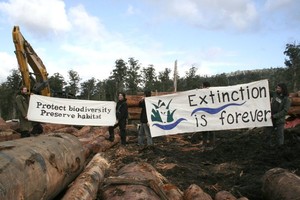
Title of this article is derived from two well known sayings:
- ‘Forgive them, for they know not what they do.’ Source: The Bible: ‘And Jesus said, “Father, forgive them, for they know not what they do.” And they cast lots to divide his garments.’
[© English Standard Version, Luke (23:34) 2001)]. These are supposedly Jesus’ words from the cross, asking forgiveness for those who put him to death. More widely, of course, the plea was for all humanity. [Rare historic photos of these magnificent trees are all that allow us to remember what once was. The saying is quite apt to old-growth trees, though I have removed the ‘Father, forgive them‘ clause.]
- ‘Lest we forget‘ Source: Rudyard Kipling’s poem of 1897, ‘Recessional’, which he composed on the occasion of Queen Victoria’s Diamond Jubilee in 1897. The poem, on the one hand, expresses pride in the British Empire, but, on the other, expresses an underlying sadness that the Empire might go the way of all previous empires. [Again, quite apt to old-growth trees.]
.
‘God of our fathers, known of old—
Lord of our far-flung battle line—
Beneath whose awful hand we hold
Dominion over palm and pine—
Lord God of Hosts, be with us yet,
Lest we forget—lest we forget!
The tumult and the shouting dies—
The Captains and the Kings depart—
Still stands Thine ancient sacrifice,
An humble and a contrite heart.
Lord God of Hosts, be with us yet,
Lest we forget—lest we forget!
Far-called our navies melt away—
On dune and headland sinks the fire—
Lo, all our pomp of yesterday
Is one with Nineveh and Tyre!
Judge of the Nations, spare us yet,
Lest we forget—lest we forget!
If, drunk with sight of power, we loose
Wild tongues that have not Thee in awe—
Such boastings as the Gentiles use,
Or lesser breeds without the Law—
Lord God of Hosts, be with us yet,
Lest we forget—lest we forget!
For heathen heart that puts her trust
In reeking tube and iron shard—
All valiant dust that builds on dust,
And guarding calls not Thee to guard.
For frantic boast and foolish word,
Thy Mercy on Thy People, Lord!
Amen.
.
– end of article –
Tags: Centennial Exhibition Tree, Dandenongs, Eucalyptus regnans, Gippsland, Gippsland Giants, Logging, Menzies Creek, Mountain Ash, Mt Baw Baw, Mueller Tree, old growth, The Baron, The Big Tree, The Bulga Stump, Thorpdale, world's largest trees
Posted in Gippsland (AU), Threats from Deforestation | No Comments »
Add this post to Del.icio.us - Digg
Wednesday, August 17th, 2011
The following article was initially posted by Tigerquoll on 20090423 on CanDoBetter.net:
.
I have to pinch myself to realise this is 2009 and not 1959!
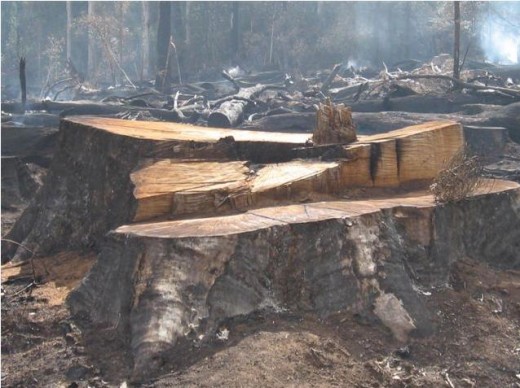 Vicforests’ logging arson to 600 year old Eucalyptus regnans in East Gippsland, Victoria, Australia, 20090423
http://www.lighterfootprints.org/2009/04/brown-mountain-destruction-complete.html Vicforests’ logging arson to 600 year old Eucalyptus regnans in East Gippsland, Victoria, Australia, 20090423
http://www.lighterfootprints.org/2009/04/brown-mountain-destruction-complete.html
This photo just in from the old growth forests of Brown Mountain in East Gippsland – home of remnant giant Australian natives dating up to 600 years old. This photo shows the Brown Mountain Massacre yesterday (23 April 2009) of these magnificent giants by VicForests on its celebrated World Forestry Day.
In 2006, the then Premier, Steve Bracks, made a promise to “protect all significant stands of old growth currently available for logging” (hollow words by a man of renouned indecision). The immense trees that have sheltered and raised hundreds of generations of owls and gliding possums are now being hacked down by VicForests.” [Source: Environment East Gippsland’s, ‘The Potoroo Review‘, Issue 196]
VicForests’ leadership inspiration, Warren Hodgson, must feel pround leaving such a legacy of heritage denial to future Gippslanders, Victorian and Australians. “Warren Hodgson has been involved in policy development at the highest level of the Victorian public sector and has previously led the Victorian Government efforts on Public Private Partnerships. He has a background in the manufacturing industry in New Zealand and in the provision of contract services to public and private sectors throughout the Asia-Pacific region.”
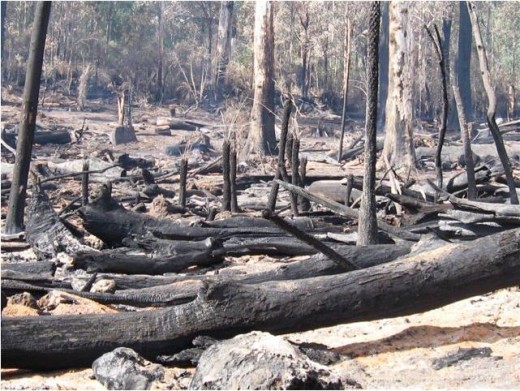
.
.
.
‘VicForests’ (from its website) presents its vision and values as:
.
Our vision:
“To be a leader in a sustainable Victorian timber industry.”
Our purpose:
“To build a responsible business that generates the best community value from the commercial management of Victoria’s State forests.”
Our values:
“Accountable – VicForests is accountable to the Victorian Government. Its actions and those of its employees must be consistent with relevant Government policy and priorities.”
Committed – “VicForests is committed to the fulfilment of its purpose and the achievement of its vision for the Victorian timber industry.”
Safe – “VicForests and its staff will manage safe workplaces for all staff and contractors, and are committed to continuous improvement in safety systems and outcomes, in accordance with its Occupational Health and Safety Policy.”
Customer focused – “VicForests will be responsive to its customers’ requirements and seek customer satisfaction, in accordance with its commercial nature.”
Ethical – “VicForests will operate in an ethical and environmentally responsible manner in all its undertakings to ensure the integrity and sustainability of the native forest timber industry in Victoria.”
Innovative – “VicForests seeks to be innovative and adaptable in its organisational, business and forestry management operations.”
Open – “VicForests will manage the commercial harvesting and sale of timber in a framework of openness and transparency.”
Professional – “VicForests and its staff will operate in a professional manner in all undertakings to ensure the best possible outcomes for the organisation, its customers, the Victorian timber industry and its stakeholders.”
Sustainable – “VicForests will pursue the highest standards for forest management practices through the continued development of its Sustainable Forest Management System and by ensuring its triple bottom line performance against the requirements of Victoria’s Sustainability Charter for State forests.”
[SOURCE: http://www.vicforests.com.au/vision-purpose-and-values.htm]
.
.
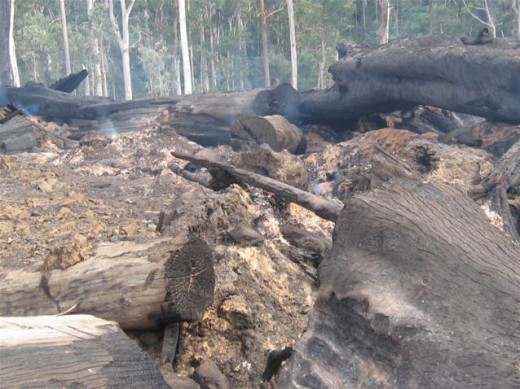
I have to pinch myself to realise this is 2009 and not 1959!
.
.
.
Brown Mountain – destruction complete!
.
An urgent message from Jill Redwood of Environment East Gippsland (from 20090424). . .
“These were taken yesterday – VicForests mission accomplished.
This ancient stand of 600(plus) year old forest has now been fully annihilated and ready for conversion to a palm-oil plantation. Or it might as well be.
They’ll actually be converted to a pulpwood plantation for the Japanese paper industry.
The other four remaining stands of old growth adjoining are on the logging schedule.
Please help in whatever way you can.”
~ Jill [Environment East Gippsland]
.
.
.
Read More:
.
[1] ^http://www.greenlivingpedia.org/Brown_Mountain_old_growth_forest
[2] ^http://www.eastgippsland.net.au/
[3] ^http://www.eastgippsland.net.au/?q=campaigns/brown_mountain
.
– end of article –
|
|
 A pastoral Bothwell ~ an ode to the British countryside
A pastoral Bothwell ~ an ode to the British countryside Bothwell
Situated in the Tasmanian South East Bioregion
Bothwell
Situated in the Tasmanian South East Bioregion
 Traditional Aboriginal Territories of Tasmania
Traditional Aboriginal Territories of Tasmania ‘Dead Heritage’
Stump of a Tasmanian Swamp Gum (Eucalyptus regnans)
on Barrack Hill, overlooking Bothwell
(Photo by Editor 2009, free in Public Domain
(click photo to enlarge, then again to enlarge again)
‘Dead Heritage’
Stump of a Tasmanian Swamp Gum (Eucalyptus regnans)
on Barrack Hill, overlooking Bothwell
(Photo by Editor 2009, free in Public Domain
(click photo to enlarge, then again to enlarge again)
 ‘Tasmanian Natural Heritage’
‘Tasmanian Natural Heritage’ ‘Tasmanian Colonial Heritage’
Oatlands’ Wind Mill
The 1837 landmark Callington Flour Mill, recently restored
(Photo by editor, September 2009, free in Public Domain)
‘Tasmanian Colonial Heritage’
Oatlands’ Wind Mill
The 1837 landmark Callington Flour Mill, recently restored
(Photo by editor, September 2009, free in Public Domain)
 The environmental cost of Tasmanian Tourism
A new ten inch (wide) post inside Oatlands’ restored mill,
probably from local Messmate/Stringybark (Eucalyptus obliqua)
(Photo by editor, September 2009, free in Public Domain)
.
The environmental cost of Tasmanian Tourism
A new ten inch (wide) post inside Oatlands’ restored mill,
probably from local Messmate/Stringybark (Eucalyptus obliqua)
(Photo by editor, September 2009, free in Public Domain)
.























 ,
, 






 Woodchip train makes its way to Midways, Geelong (2009) for as little as $2.50 per tonne.
Photo: Wilderness Society Collection
Woodchip train makes its way to Midways, Geelong (2009) for as little as $2.50 per tonne.
Photo: Wilderness Society Collection



















